Hoover DYC 8813 BX User Manual [de]
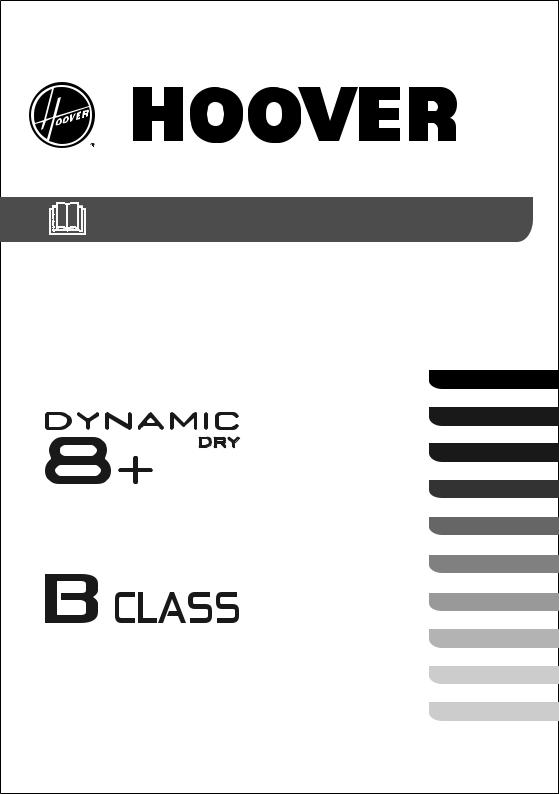
INSTRUCTION BOOK |
DYC 8813BX |
Condenser Tumble Dryer
English 2
Italiano 14
Deutsch 26
Français 38
Porteguese 50
Nederlands 62
Dansk 74
Norsk 86
Svenska 98
Suomi 110
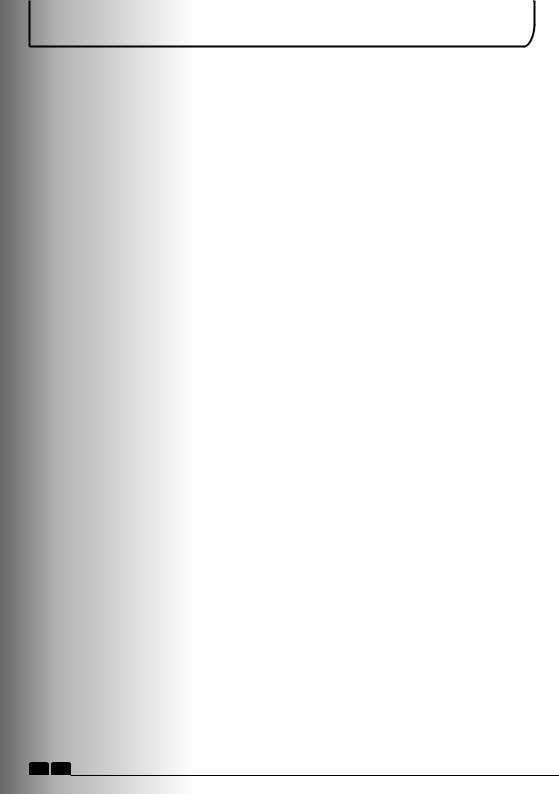
INDEX
Introduction |
3 |
Delivery Information |
3 |
Unpacking the Product |
3 |
Safety Reminders |
3 |
Use |
3 |
Installation |
4 |
The Laundry |
4 |
Environmental Issues |
4 |
Gias Service |
4 |
Installation |
5 |
Electrical Requirements |
5 |
Adjusting the Feet |
5 |
Ventilation |
5 |
Drain Hose Kit: Fitting Instructions |
6 |
Preparing the Load |
7 |
Clothes Preparation |
7 |
Do Not Tumble Dry |
7 |
Energy Saving |
7 |
Sorting the Load |
7 |
Drying Guide |
7 |
Controls and Indicators |
8 |
Selecting the Programme |
9 |
Door and Filter |
10 |
Opening the Door |
10 |
Filter |
10 |
Filter Care Indicator |
10 |
Water Container |
10 |
To Remove the Container |
10 |
Condenser |
11 |
To Remove the Condenser |
11 |
Operation |
11 |
Delay Start Function |
12 |
Cancelling and Resetting the Programme |
12 |
Cleaning and Routine Maintenance |
12 |
Cleaning the Dryer |
12 |
Technical Specifications |
12 |
Troubleshooting |
13 |
Customer Service |
13 |
Spares |
13 |
Gias Service |
13 |
EN 2
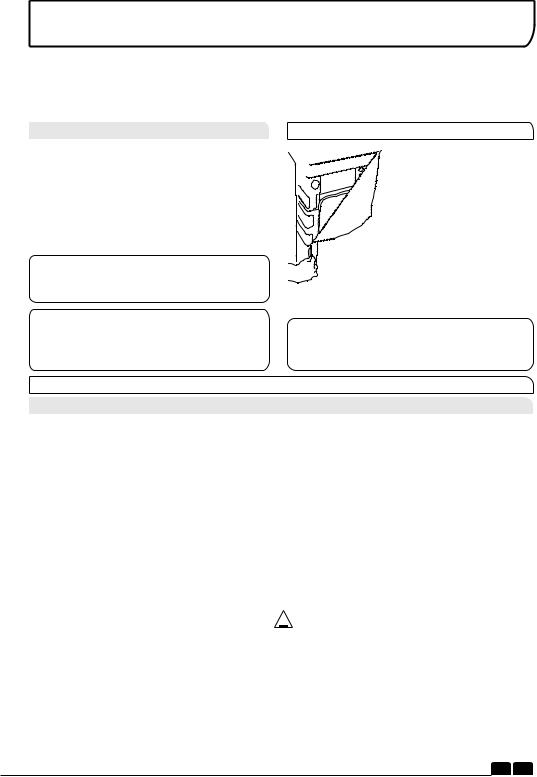
INTRODUCTION
Please read and follow these instructions carefully and operate the machine accordingly. This booklet provides important guidelines for safe use, installation, maintenance and some useful advice for best results when using your machine.
Keep all documentation in a safe place for future reference or for any future owners.
Delivery Information
Please check that the following items are delivered with the appliance:
●Instruction manual
●Guarantee card
●Energy label
 Check that no damage has occurred to the machine during transit. If it has, call for service by GIAS.
Check that no damage has occurred to the machine during transit. If it has, call for service by GIAS.
 Failure to comply with the above can compromise the safety of the appliance. You may be charged for a service call if a problem with your machine is caused by misuse.
Failure to comply with the above can compromise the safety of the appliance. You may be charged for a service call if a problem with your machine is caused by misuse.
SAFETY REMINDERS
Use
UNPACKING THE PRODUCT
Remove the machine from its packaging close to the f i n a l l o c a t i o n o f t h e machine.
1- Cut carefully around the base of the packaging and up one corner.
2- Remove the polythene sleeve and lift the dryer off the polystyrene base.
 Dispose of the packaging safely. Make sure it is out of the reach of children,it is a potential source of danger.
Dispose of the packaging safely. Make sure it is out of the reach of children,it is a potential source of danger.
●This appliance is not intended for use by persons (including children) with reduced physical, sensory or mental capabilities,or lack of experience and knowledge, unless they have been given supervision or instruction concerning use of the appliance by a person responsible for their safety.
●Children should be supervised to ensure that they do not play with the appliance.
●WARNING Misuse of a tumble dryer may create a fire hazard.
●This machine is solely for domestic use, i.e. to dry household textiles and garments.
●This machine should only be used for its intended purpose as described in this manual. Ensure that the instructions for installation and use are fully understood before operating the appliance.
●Do not touch the appliance when hands or feet are damp or wet.
●Do not lean on the door when loading the machine or use the door to lift or move the machine.
●Do not allow children to play with the machine or its controls.
● WARNING Do not use the product if the fluff filter is not in position or is damaged; fluff could be ignited.
●WARNING Where the hot surface symbol is  located the temperature rise during operation of the tumble dryer may be in excess of 60 degrees C.
located the temperature rise during operation of the tumble dryer may be in excess of 60 degrees C.
● Remove the plug from the electricity supply. Always remove the plug before cleaning the appliance.
●Do not continue to use this machine if it appears to be faulty.
●Lint and fluff must not be allowed to collect on the floor around the outside of the machine.
●The drum inside may be very hot. Always allow the dryer to complete the cool down period before removing the laundry.
EN 3

SAFETY REMINDERS
Installation |
Environmental Issues |
●Check that the product has no visible signs of damage before use. If damaged do not use and please call GIAS Service.
●Do not use adapters, multiple connectors and/or extensions.
●Never install the dryer against curtains and be sure to prevent items from falling or collecting behind the dryer.
●The appliance must not be installed behind a lockable door, a sliding door or a door with a hinge on the opposite side to that of the tumble dryer.
●All packaging materials used are environmentally-friendly and recyclable. Please help dispose of the packaging via environmentally-friendly means. Your local council will be able to give you details of current means of disposal.
●To ensure safety when disposing of an old tumble dryer disconnect the mains plug from the socket, cut the mains power cable and destroy this together with the plug. To prevent children shutting themselves in the machine break the door hinges or the door lock.
The Laundry
●Do not dry unwashed items in the tumble dryer.
●WARNING Do not tumble dry fabrics treated with dry cleaning fluids.
●WARNING Foam rubber materials can, under certain circumstances, when heated become ignited by spontaneous combustion. Items such as foam rubber (latex foam), shower caps, waterproof textiles, rubber backed articles and clothes or pillows fitted with foam rubber pads MUST NOT be dried in the tumble dryer.
●Always refer to the laundry care labels for directions on suitability for drying.
●Clothes should be spin dried or thoroughly wrung before they are put into the tumble dryer. Clothes that are dripping wet should not be put into the dryer.
●Lighters and matches must not be left in pockets and NEVER use flammable liquids near the machine.
●Glass fibre curtains should NEVER be put in this machine. Skin irritation may occur if other garments are contaminated with the glass fibres.
●Items that have been soiled with substances such as cooking oil, acetone, alcohol, petrol, kerosene, spot removers, turpentine, waxes and wax removers should be washed in hot water with an extra amount of detergent before being dried in the tumble dryer.
●Fabric softeners, or similar products, should be used as specified by the fabric softener instructions.
European Directive 2002/96/EC
This appliance is marked according t o t h e E u r o p e a n d i r e c t i v e 2002/96/EC on Waste Electrical and Electronic Equipment (WEEE).
By ensuring this product is disposed of correctly, you will help prevent potential negative consequences for the environment and human health, which could otherwise be caused by inappropriate waste handling of this product.
The symbol on the product indicates that this product may not be treated as household waste. Instead it shall be handed over to the applicable collection point for the recycling of electrical and electronic equipment.
For more detailed information about treatment, recovery and recycling of this product, please contact your local city office,your household waste disposal service or the shop where you purchased the product. Disposal must be carried out in accordance with local environmental regulations for waste disposal.
GIAS Service
● To ensure the continued safe and efficient operation of this appliance we recommend that any servicing or repairs are only carried out by an authorised GIAS service engineer.
 If the appliance is not running properly or breaks down, switch it off and disconnect the plug from the socket. Consult GIAS Service for possible repair.
If the appliance is not running properly or breaks down, switch it off and disconnect the plug from the socket. Consult GIAS Service for possible repair.
EN 4
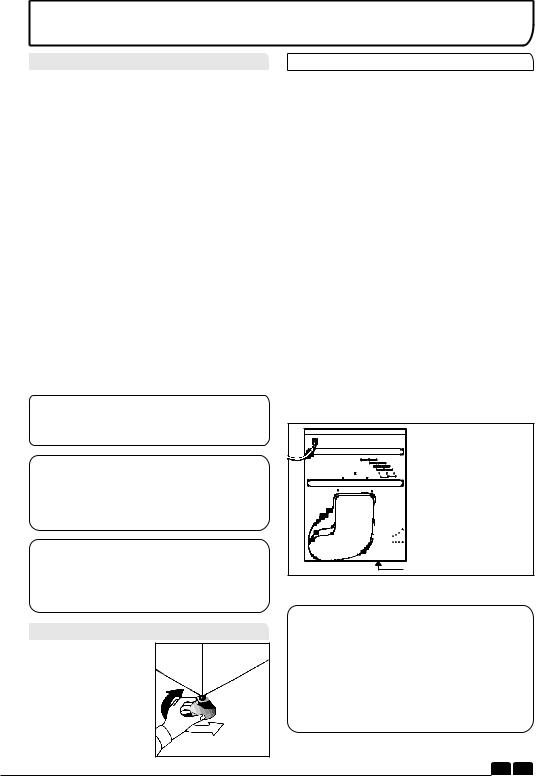
Electrical Requirements
Tumble dryers are supplied to operate at a voltage of 230V, 50 Hz single phase. Check that the supply circuit is rated to at least 10A
Electricity can be extremely dangerous.
This appliance must be earthed.
The socket outlet and the plug on the appliance must be of the same type.
Do not use multiple adapters and/or extension leads.
The plug should be accessible for disconnection after the appliance has been installed.
CE Appliance complies with European Directive 2004/108/EC, 2006/95/EC and subsequent amendments.
 You may be charged for a service call if a problem with your machine is caused by incorrect installation.
You may be charged for a service call if a problem with your machine is caused by incorrect installation.
 If the mains cord on this appliance is damaged, it must be replaced by a special cord which is ONLY obtainable from the spares service. It must be installed by a competent person.
If the mains cord on this appliance is damaged, it must be replaced by a special cord which is ONLY obtainable from the spares service. It must be installed by a competent person.
 Do not plug the machine in and switch it on at the mains until the installation is completed.For your safety, this dryer must be correctly installed. If there is any doubt about installation, call GIAS Service for advice.
Do not plug the machine in and switch it on at the mains until the installation is completed.For your safety, this dryer must be correctly installed. If there is any doubt about installation, call GIAS Service for advice.
Adjusting the Feet
Once the machine is in place the feet should be adjusted to ensure that the machine is level.
INSTALLATION
VENTILATION
Adequate ventilation must be provided in the room where the tumble dryer is located to prevent gases from appliances burning other fuels, including open fires, being drawn into the room during operation of the tumble dryer.
●Exhaust air must not be discharged into a flue which is used for exhausting fumes from appliances burning gas or other fuels.
●Check regularly that the air flowing through the dryer is not restricted.
●Check the fluff filter after use, and clean, if necessary.
●The inlet and outlets should be kept free from obstructions. To ensure adequate ventilation the space between the bottom of the machine and the floor must not be obstructed. There should be a gap of at least 12mm between the machine and any obstructions.
●Prevent items from falling or collecting behind the dryer as these may obstruct the air inlet and outlet.
●NEVER install the dryer up against curtains.





 Air Inlent Vents
Air Inlent Vents




 Air Outlets
Air Outlets
Air Outlets in the Base
 Do not install the product in a room where there is a risk of frost occurring. At temperature around freezing point the product may not be able to operate properly: there is a risk of damage if the water is allowed to freeze in the hydraulic circuit (valves, hoses, pumps).
Do not install the product in a room where there is a risk of frost occurring. At temperature around freezing point the product may not be able to operate properly: there is a risk of damage if the water is allowed to freeze in the hydraulic circuit (valves, hoses, pumps).
For a better product performance the ambient room temperature must be between +2°C and +35°C.
EN 5
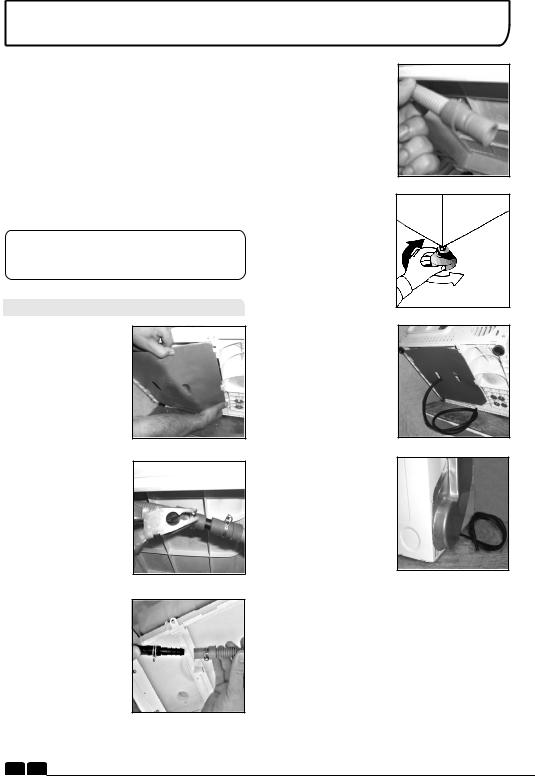
DRAIN HOSE : FITTING INSTRUCTIONS
To avoid emptying the water container after each drying cycle, the water can be discharged directly to a waste water drain pipe (the same drainage system as household sinks). Water Bye-Laws prohibit connection to a surface water drain. The waste water drain pipe should be located adjacent to the tumble dryer.
The kit consists of:1 hose and 1 tap.
 WARNING! Switch off and remove the tumble dryer plug from the electricity supply before carrying out any work.
WARNING! Switch off and remove the tumble dryer plug from the electricity supply before carrying out any work.
Fit the Hose as Follows:
1.Tilt the machine backwards.
2.Remove the bottom protector panel, by pulling carefully to the left side.
3.The waste water pipe is situated at the right-hand side of the machine (see the picture). A grey hose connects to the bridge at the left hand side of the machine. Using pliers, remove the pipe retaining clip from the bridge.
4.Pull the hose off the bridge connection.
5.Attach the black
hose from the kit, (using the connector a n d p i p e c l i p s supplied), to the hose removed from the bridge connection.
6 . P l a c e t h e t a p supplied by the kit to close the remaing hose.
7.Feed the drain hose through the hole in the b o t t o m p r o t e c t o r panel.
8.Carefully slide the bottom protector panel back into position ensuring that the hose is not trapped.
9.Once the machine is in place the feet should be adjusted to ensure that the new hose does not kink when pushing the tumble dryer into position.
10.Connect the new drain hose to the waste Water pipe.
11.Connect to the m a i n s e l e c t r i c i t y supply.
EN 6
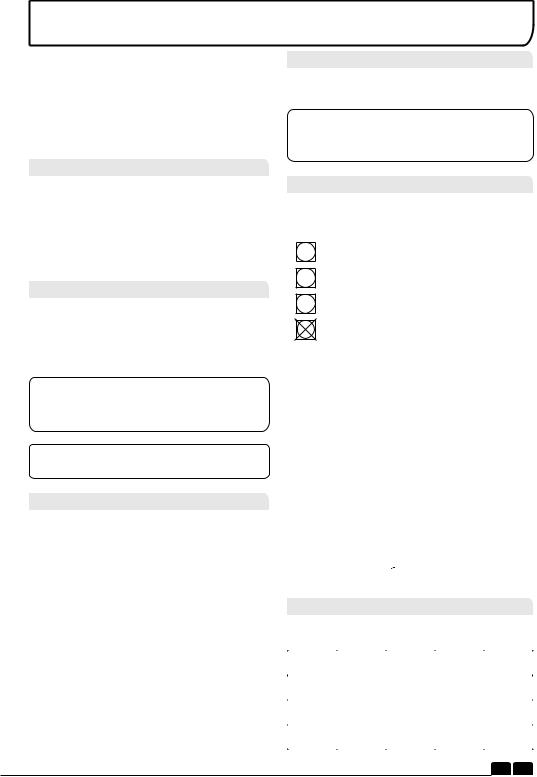
Before using the tumble dryer for the first time:
●Please read this instruction book thoroughly.
●Remove all items packed inside drum.
● Wipe the inside of the drum and door with a damp cloth to remove any dust which may have settled in transit.
Clothes Preparation
Make sure that the laundry you are going to dry is suitable for drying in a tumble dryer, as shown by the care symbols on each item.
Check that all fastenings are closed and that pockets are empty. Turn the articles inside out. Place clothes loosely in the drum to make sure that they don't get tangled.
Do Not Tumble Dry:
Woollens, silk, delicate fabrics, nylon stockings, delicate embroidery, fabrics with metallic decorations, garments with PVC or leather trimmings, training shoes, bulky items such as sleeping bags, etc.
 IMPORTANT: Do not dry articles which have been treated with a dry cleaning fluid or rubber clothes (danger of fire or explosion).
IMPORTANT: Do not dry articles which have been treated with a dry cleaning fluid or rubber clothes (danger of fire or explosion).
During the last 15 minutes (roughly) the load is always tumbled in cool air
Energy Saving
Only put into the tumble dryer laundry which has been thoroughly wrung or spin-dried. The drier the laundry the shorter the drying time thus saving electricity.
ALWAYS
●Try to dry the maximum weight of laundry, this will save time and electricity.
●Check that the filter is clean before every drying cycle.
NEVER
●Exceed the maximum weight, this will waste time and electricity.
●Put dripping wet items into the tumble dryer, this may damage the appliance.
PREPARING THE LOAD
Maximum Drying Weight
● |
Cottons |
Max. 8 kg |
● |
Synthetics |
Max. 4 kg |
 Do not overload the drum, large items when wet can exceed the maximum admissible clothes load (for example: sleeping bags, duvets).
Do not overload the drum, large items when wet can exceed the maximum admissible clothes load (for example: sleeping bags, duvets).
Sort the Load as Follows
●By care symbols
These can be found on the collar or inside seam:
Suitable for tumble drying.
. . Tumble drying at high temperature.
. Tumble drying at low temperature only.
Do not tumble dry.
If the item does not have a care label it must be assumed that it is not suitable for tumble drying.
●By amount and thickness
Whenever the load is bigger than the dryer capacity, separate clothes according to thickness (e.g. towels from thin underwear).
●By type of fabric
Cottons/linen: Towels, cotton jersey, bed and
table linen.
Synthetics: Blouses, shirts, overalls, etc. made of polyester or polyamid, as well as for cotton/synthetic mixes.
●By drying level
Sort into: iron dry, cupboard dry, etc. For delicate articles press the  button to select low drying temperature.
button to select low drying temperature.
Drying Guide
The table shows approximate drying times,depending on the type of fabric and dampness of the clothes.
FABRIC |
HEAT |
HEAVY |
MEDIUM |
LIGHT |
|
SETTING |
LOAD |
LOAD |
LOAD |
||
|
|||||
COTTON |
HIGH |
140-165min |
70-80min |
50-65min |
|
|
|
|
|
|
|
SYNTHETICS |
LOW |
--- |
70-80min |
40-55min |
|
|
|
|
|
|
|
ACRYLIC |
LOW |
--- |
50-65min |
30-40min |
|
|
|
|
|
|
EN 7

CONTROLS AND INDICATORS
Programme |
Empty Water |
Filter Care |
Program |
Start/Pause |
Selector |
Indicator |
Indicator |
Display |
Button |
Time Selection |
Delay Start |
Acrylic Synthetic |
Anti-Crease |
Button |
Button |
Button |
Button |
Control Panel and Indicator Lights
Programme Selector – Select the required programme
Time Selection Button  – Allows the user to change duration of the programme selected by Programme Selector. It can be used only with the selection of: Mix&Dry, Shirts and Time Programmes
– Allows the user to change duration of the programme selected by Programme Selector. It can be used only with the selection of: Mix&Dry, Shirts and Time Programmes
Delay Start Button  – Allows the user to delay the start of the drying cycle (see details of Operation )
– Allows the user to delay the start of the drying cycle (see details of Operation )
Acrylic and Synthetic Button – When pressed the  default indicator will fade and
default indicator will fade and 
 will be illuminated
will be illuminated
AntiCrease Button  – Allows the user to select a post drying anti-crease cycle. Start/Pause Button
– Allows the user to select a post drying anti-crease cycle. Start/Pause Button  – Press to commence/ to pause the selected drying programme.
– Press to commence/ to pause the selected drying programme.
Memo Button – Allows user to record the programme by pressing simultaneously the AntiCrease and the Acrylic Synthetic buttons for 3 seconds, after 2 minutes duration of the chosen programme/option
Filter Care indicator  – lights when the filter needs cleaning Empty Water indicator
– lights when the filter needs cleaning Empty Water indicator  – lights when the water container is full
– lights when the water container is full
Program Display – Related indicator lights when a auto programme has been selected.  - Indicator will come on when the eco programme has been selected.
- Indicator will come on when the eco programme has been selected.
Refresh  – The indicator lights up when the programme starts the cool down stage.
– The indicator lights up when the programme starts the cool down stage.
SELECTING THE PROGRAMME
The Hoover Sensor Dry machine gives many options for drying the laundry to suit all circumstances. The table on the next page lists the programmes and the function of each programme.
Note:
The sensor may not detect a small load of small articles. For small loads and separate items or pre-dried fabrics with low moisture content, use the timed programmes.
If the sensor does not detect the item the dryer will only operate for 10 minutes before going into cooldown.
If the load is too large or too wet to tumble dry the dryer will automatically go into cooldown after approximately 3 hours.
In these cases we advise to use a time cycles between 30 and 75minutes depending on the load size and dryness required, and select high or low heat depending upon the fabric type.
EN 8

SELECTING THE PROGRAMME
PROGRAMME |
DESCRIPTION |
|
|
|
|
||
Bone Dry |
Select the degree of dryness that you require. This range from |
||
Store Dry |
|||
for bath towels and bathrobes, through |
for items that will be |
||
Hang Dry |
put away without ironing, to the programme that leaves the laundry |
||
|
suitable for ironing. |
|
|
Iron Dry |
|
||
|
|
||
Relax |
The programme provides a conditioning and anticrease function. |
||
|
The dryer will heat the load for 9 minutes followed by a 3 minute cool |
||
|
down period and is especially good for garments which may have |
||
|
been left for some time prior to ironing, in a linen basket for |
||
|
example. Garments may also become stiffened when dried outside |
||
|
on a washing line or inside on radiators. |
|
|
|
This programme relaxes the creases in the fabric making ironing |
||
|
quicker and easier. |
|
|
|
|
||
Wool Finish |
A gentle programme specially created to get woollens softer after |
||
|
air-drying.This delicate warm air cycle, lasting 12 minutes, can |
||
|
also be used to get woollens 'refreshed' after being stored in the |
||
|
wardrobe. |
|
|
|
|
||
Mix & Dry |
This is a special timed program for a maximum load of 4kg (117 |
||
|
min). The default duration is 99 minutes and allows to dry up to 3kg. |
||
|
With this program you can dry together cotton and synthetic |
||
|
fabrics. |
|
|
|
|
||
Shirts |
This is a special timed program for shirts of max load of 3kg (78 |
||
|
minutes). For synthetic shirts you have to press the Acrylic |
||
|
Synthetic button. The default duration is 60 minutes and allows to |
||
|
dry up to 2kg. |
|
|
|
|
||
Rapid 40' |
The Rapid 40' programme allows a drying cycle to be completed |
||
|
quickly. This is an ideal programme for having dry, refreshed and |
||
|
ready-to-wear clothes in less than 40'. This special programme |
||
|
constantly monitors the temperature in the drum. The maximum load |
||
|
is 2 kg and the programme is suitable for all types of fabrics where |
||
|
tumble drying is appropriate. |
|
|
|
|
||
Time |
Time selection includes all the manual time programs: from 30 |
||
|
minutes to 180 minutes. The 20 minutes selection time in only cool |
||
|
air ventilation (Refresh) |
|
|
|
|
||
Memo |
Memo Program allows to re-perform a program that the user has |
||
|
saved before, without selecting the correct sequence of program |
||
|
selector positions and option buttons for that particular program. |
||
|
|
|
|
EN 9
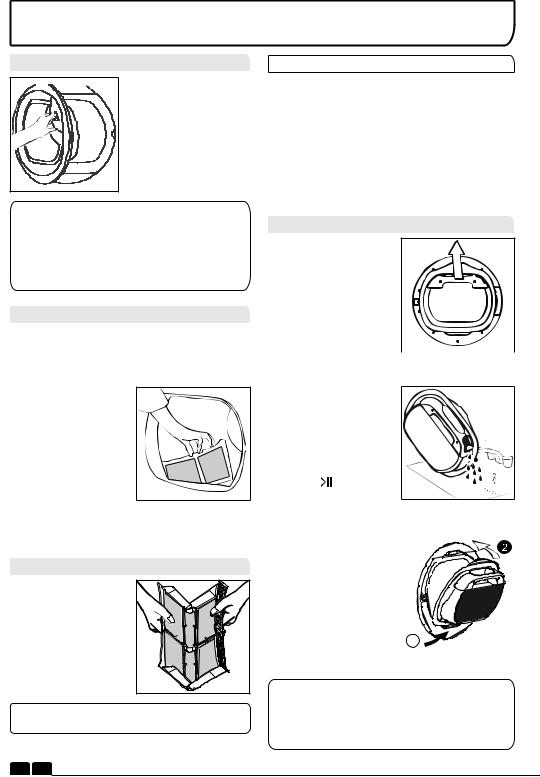
Opening the Door
Pull on handle to open the door.
To restart the dryer, close the door and press  .
.
 WARNING! When the tumble dryer is in use the drum and door may be VERY HOT. Never stop a tumble dryer before the end of the drying cycle unless all items are quickly removed and spread out so that the heat is dissipated.
WARNING! When the tumble dryer is in use the drum and door may be VERY HOT. Never stop a tumble dryer before the end of the drying cycle unless all items are quickly removed and spread out so that the heat is dissipated.
Filter
IMPORTANT: To maintain the efficiency of the dryer check that the fluff filter is clean before each drying cycle.
1 . P u l l t h e f i l t e r upwards.
2. Open filter as shown.
3. Gently remove lint using a soft brush or your fingertips.
4 . S n a p t h e f i l t e r together and push back into place.
Filter Care Indicator
 Lights when the filter needs cleaning.
Lights when the filter needs cleaning.
If the laundry is not drying check that the filter is not clogged.
 DO NOT USE WATER TO CLEAN THE FILTER.
DO NOT USE WATER TO CLEAN THE FILTER.
DOOR and FILTER
WATER CONTAINER
The water removed from the laundry during the drying cycle is collected in a container inside the door of the dryer. When the container is full the  indicator on the control panel will light, and the container MUST be emptied. However, we recommend that the container is emptied after each drying cycle.
indicator on the control panel will light, and the container MUST be emptied. However, we recommend that the container is emptied after each drying cycle.
NOTE: Very little water will collect during the first few cycles of a new machine as an internal reservoir is filled first.
To Remove the Container
1. Gently pull out the w a t e r c o n t a i n e r holding the handle.
When it is full the water container will weigh about 6 kg.
2 . Ti l t t h e w a t e r |
|
|||
container to empty the |
|
|||
water out through the |
|
|||
|
||||
spout. |
|
|
|
|
When |
empty, replace |
|
||
the water |
container |
|
||
back |
as shown; |
first |
|
|
insert the base of the |
|
|||
container into position |
|
|||
as shown then gentle |
|
|||
push |
the |
top |
into |
|
position. |
|
|
|
|
3. Press |
Button to |
|
||
restart the cycle. |
|
|
||
NOTE: If you have the |
|
|||
option of drainage near |
|
|||
|
||||
to the dryer you can |
|
|||
use the discharge kit to |
|
|||
provide a |
permanent |
|
||
drainage for the water |
|
|||
c o l l e c t e d i n t h e |
|
|||
container of the dryer. |
|
|||
This |
means that you |
1 |
||
don't have to empty the |
||||
water container. |
|
|
||
 WARNING! If you open the door mid cycle, before the cool-down cycle has completed,the handle may be hot. Please use extreme caution when attempting to empty the water reservoir during the cycle.
WARNING! If you open the door mid cycle, before the cool-down cycle has completed,the handle may be hot. Please use extreme caution when attempting to empty the water reservoir during the cycle.
EN 10
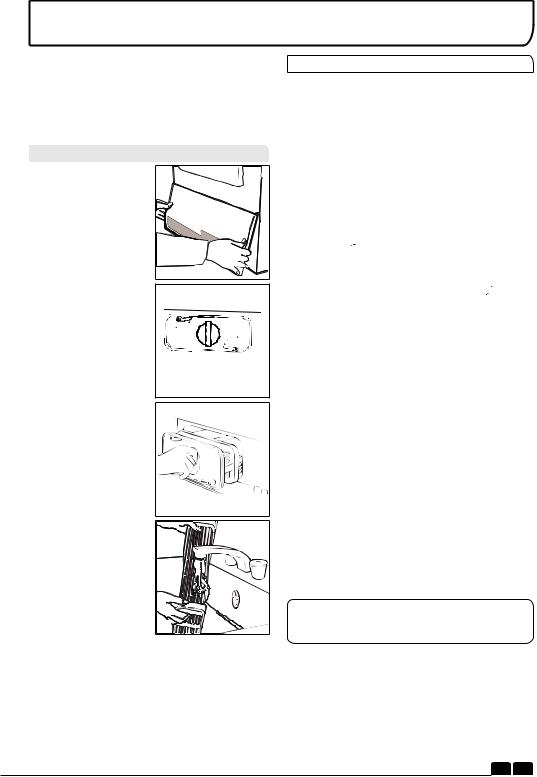
CONDENSER
Important: Always switch off and remove the plug from the electricity supply before cleaning the condenser.
To maintain the efficiency of the dryer regularly check that the condenser is clean.
To Remove the Condenser
1 . R e m o v e t h e |
|
kickplate. |
|
2. Turn the two locking |
|
levers |
anti-clockwise |
a n d p u l l o u t t h e |
|
condenser. |
|
3 . P u l l o u t t h e |
|
condenser unit. |
|
4. Gently remove any dust or fluff with a cloth, then wash the unit by holding it under a running tap turning it so that water flows between the plates, to remove any dust or fluff.
5. Refit the condenser ensuring it is in the c o r r e c t w a y ( a s indicated by the arrow) and pushed firmly into place. Lock the two levers by turning them clockwise.
6. Refit the kickplate.
OPERATION
1.Open the door and load the drum with laundry. Ensure that garments do not hinder closure of the door.
2.Gently close the door pushing it slowly until you hear the door 'click' shut.
3.Turn the Programme Selector dial to select the required drying programme (see Programme Guide).
4.If drying synthetics, acrylics or delicate items, press the  button to reduce the heat level. The indicator will light up when the machine is in
button to reduce the heat level. The indicator will light up when the machine is in
low heat setting. To deselect in the first few minutes of the programme, press the button
button
,after this time reset the machine to change the setting.
5.Press the  button. The dryer will start automatically and the indicator above the
button. The dryer will start automatically and the indicator above the
button will be continuously lit.
6.If the door is opened during the programme to check the laundry, it is necessary to press to recommence drying after the door has been
to recommence drying after the door has been
closed.
7.When the cycle is nearing completion the machine will enter the cool down phase, the clothes will be tumbled in cool air allowing the load to cool down.
8.Following the completion of the cycle the drum will rotate intermittently to minimize creasing. This will continue until the machine is switched OFF or the door is opened.
 Do not open the door during the automatic programs in order to obtain a proper drying.
Do not open the door during the automatic programs in order to obtain a proper drying.
EN 11

OPERATION
Delay Start Function
The Delay Start Function  allows the user to delay the start of the drying cycle by 1 to 24 hours.
allows the user to delay the start of the drying cycle by 1 to 24 hours.
When the function is first selected the display will show a delay of 1 hour, subsequent presses of the button will increase the delay with 1 hour steps.
To commence the programme press  and the appliance will complete the drying cycle at the end of this time. The indicator light will flash to indicate that the start delay is in progress.
and the appliance will complete the drying cycle at the end of this time. The indicator light will flash to indicate that the start delay is in progress.
Cancelling and Resetting the Programme
To cancel a programme press the  button for 3 seconds. In the TIME CONTROL display 0:00 Light will flash to indicate that it has been reset.
button for 3 seconds. In the TIME CONTROL display 0:00 Light will flash to indicate that it has been reset.
CLEANING AND ROUTINE MAINTENANCE
Cleaning the Dryer
●Clean the filter and empty the water container after every drying cycle.
●Regularly clean the condenser.
●After each period of use, wipe the inside of the drum and leave the door open for a while to allow circulation of air to dry it.
●Wipe the outside of the machine and the door with a soft cloth.
●DO NOT use abrasive pads or cleaning agents.
Technical Specifications
Drum capacity |
115 litres |
Maximum load |
8 kg |
Height |
85 cm |
Width |
60 cm |
Depth |
60 cm |
Energy Label Band |
B |
Information for Test Laboratory |
|
EN 61121 Programme |
Programme To Use |
-DRY COTTON |
-HANG DRY |
-IRON DRY COTTON |
-IRON DRY |
-EASY-CARE TEXTILE |
-HANG DRY + SYNTHETIC |
● To prevent the door sticking or the build up of fluff clean the inner door and gasket with a damp cloth after every drying cycle.
 WARNING! The Drum, door and load may be very hot.
WARNING! The Drum, door and load may be very hot.
 IMPORTANT Always switch off and remove the plug from the electricity supply before cleaning this appliance.
IMPORTANT Always switch off and remove the plug from the electricity supply before cleaning this appliance.
 For electrical data refer to the rating label on the front of the dryer cabinet (with the door open).
For electrical data refer to the rating label on the front of the dryer cabinet (with the door open).
EN 12

TROUBLESHOOTING
What Might be the Cause of...
Defects you can remedy yourself
Before calling GIAS Service for technical advice please run through the following checklist. A charge will be made if the machine is found to be working or has been installed incorrectly or used incorrectly.
If the problem persists after completing the recommended checks, please call GIAS Service, they may be able to assist you over the telephone.
Time display to end could change during drying cycle. The time to end is continuously checked during the drying cycle and the time is adjusted to give the best estimation time. The displayed time may increase or decrease during the cycle and this is normal.
Drying time is too long/clothes are not dry enough…
●Have you selected the correct drying time/programme?
●Were the clothes too wet? Were the clothes thoroughly wrung or spindried?
●Does the filter need cleaning?
●Is the dryer overloaded?
●Has the  option been selected from a previous cycle?
option been selected from a previous cycle?
The dryer is noisy…
● Switch off the dryer and contact GIAS Service
for advice.
The  Indicator is on…
Indicator is on…
●Does the filter need cleaning?
The  Indicator is on…
Indicator is on…
●Does the water container need emptying?
CUSTOMER SERVICE
Should there still be a problem with your dryer after completing all the recommended checks, please call GIAS Service for advice.
They may be able to assist you over the telephone or arrange for a suitable appointment for an engineer to call under the terms of your guarantee. However, a charge may be made if any of the following applies to your machine:
●Is found to be in working order.
●Has not been installed in accordance with the installation instructions.
●Has been used incorrectly.
The dryer does not operate…
●Is there a working electricity supply to the dryer? Check using another appliance such as a table lamp.
●Is the plug properly connected to the mains supply?
●Is there a power failure?
●Has the fuse blown?
●Is the door fully closed?
●Is the dryer switched on, both at the mains supply and at the machine?
●Has the drying time or the programme been selected?
●Has the machine been switched on again after opening the door?
Spares
Always use genuine spares, available direct from GIAS Service.
GIAS Service
For service and repairs call your local GIAS Service engineer.
The manufacturer declines all responsibility in the event of any printing mistakes in this booklet. The manufacturer also reserves the right to make appropriate modifications to its products without changing the essential characteristics.
EN 13

INDICE
Introduzione |
15 |
Informazioni Sulla Consegna |
15 |
Estrazione Del Prodotto Dall’imballaggio |
15 |
Consigli di Sicurezza |
15 |
Utilizzo |
15 |
Installazione |
16 |
La Biancheria |
16 |
Tutela Dell’ambiente |
16 |
Servizio Gias |
16 |
Installazione |
17 |
Requisiti Elettrici |
17 |
Regolazione dei Piedini |
17 |
Ventilazione |
17 |
Kit Di Montaggio Tubo Di Scarico: Istruzioni Per Il Montaggio |
18 |
Preparazione della Biancheria |
19 |
Preparazione dei Capi |
19 |
Evitare di Asciugare |
19 |
Risparmio Energia |
19 |
Selezione della Biancheria |
19 |
Guida Ad una Corretta Asciugatura |
19 |
Comandi e Spie Di Segnalazione |
20 |
Selezione del Programma |
21 |
Portellone e Filtro |
22 |
Apertura del Portellone |
22 |
Filtro |
22 |
Spia di Pulizia Filtro |
22 |
Vaschetta Dell’acqua |
22 |
Per Togliere La Vaschetta |
22 |
Condensatore |
23 |
Per Togliere Il Condensatore |
23 |
Funzionamento |
23 |
Partenza Ritardata |
24 |
Annullamento e Azzeramento del Programma |
24 |
Pulizia e Manutenzione Ordinaria |
24 |
Pulizia Dell’asciugatrice |
24 |
Specifiche Tecniche |
24 |
Ricerca Guasti |
25 |
Servizio Assistenza Clienti |
25 |
Ricambi |
25 |
Servizio Assistenza Gias |
25 |
IT 14
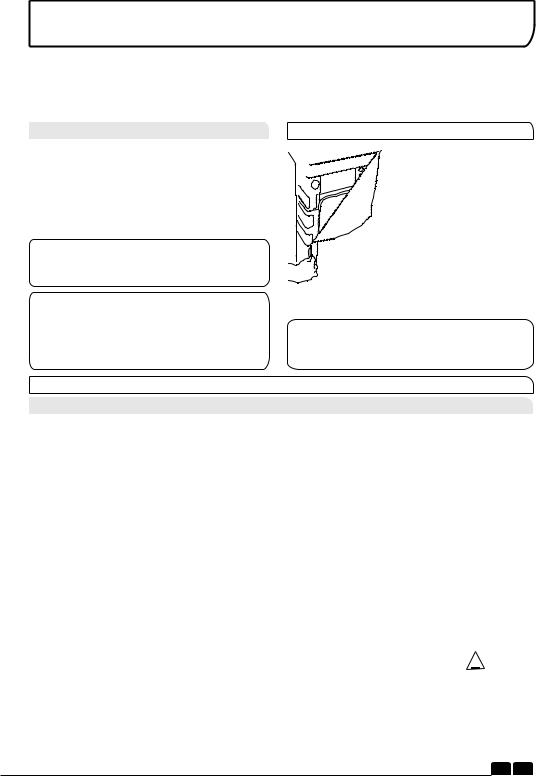
INTRODUZIONE
Leggere attentamente le istruzioni per un corretto funzionamento della macchina. Questo opuscolo fornisce importanti linee guida per una manutenzione,un uso e un'installazione sicuri. Esso contiene inoltre utili consigli che consentiranno di sfruttare al meglio le potenzialità di questa macchina.
Conservare la documentazione in un luogo sicuro per eventuali riferimenti o per futuri proprietari.
Informazioni sulla Consegna
Controllare che al momento della consegna la macchina sia dotata dei seguenti componenti:
●Libretto di istruzioni
●Certificato di garanzia
●Etichetta efficienza energetica
 Verificare che durante il trasporto la macchina non abbia subito danni. In caso contrario, rivolgersi al Centro Assistenza GIAS.
Verificare che durante il trasporto la macchina non abbia subito danni. In caso contrario, rivolgersi al Centro Assistenza GIAS.
 La mancata osservanza di tale procedura potrebbe compromettere la sicurezza dell’apparecchio. La chiamata può essere soggetta a pagamento se le cause di malfunzionamento della macchina sono attribuibili a un uso improprio.
La mancata osservanza di tale procedura potrebbe compromettere la sicurezza dell’apparecchio. La chiamata può essere soggetta a pagamento se le cause di malfunzionamento della macchina sono attribuibili a un uso improprio.
CONSIGLI DI SICUREZZA
Utilizzo
Estrazione Del Prodotto Dall’imballaggio
E s t r a r r e l a m a c c h i n a dall’imballaggio vicino al p u n t o p r e v i s t o p e r l’installazione.
1. Con cautela, eseguire un taglio lungo il perimetro della base dell’imballaggio e un altro verso l’alto, in corrispondenza di un angolo. 2.Togliere la fascia in p o l i t e n e e s o l l e v a r e l’asciugatrice togliendola dalla base di polistirolo.
 Smaltire l’imballaggio in maniera sicura. Accertarsi che sia fuori dalla portata dei bambini, in quanto fonte potenziale di rischio.
Smaltire l’imballaggio in maniera sicura. Accertarsi che sia fuori dalla portata dei bambini, in quanto fonte potenziale di rischio.
●Questo apparecchio non è destinato all'uso da parte di persone (inclusi i bambini) con capacità fisiche, sensorie o mentali ridotte, o con una mancanza di esperienza e conoscenza,a meno che esse non abbiano ricevuto supervisione o istruzione sull'uso dell'apparecchio da parte di una persona responsabile della loro sicurezza.
●I bambini dovrebbero essere controllati per garantire che essi non giochino conl'apparecchio.
●ATTENZIONE L’uso improprio dell’asciugatrice può provocare rischio di incendio.
●Questa macchina è prevista unicamente per uso domestico, ovvero per l’ asciugatura di capi e indumenti per la casa.
●La macchina qui descritta deve essere utilizzata esclusivamente per lo scopo al quale è destinata secondo quanto illustrato nel presente libretto. Prima di attivare la macchina, accertarsi di avere letto attentamente e compreso le istruzioni d’uso e di installazione.
●Non toccare l’asciugatrice con mani o piedi umidi o bagnati.
● Non appoggiarsi al portellone per caricare la macchina; non utilizzare il portellone per sollevare o
spostare la macchina.
●Non consentire ai bambini di giocare con la macchina o con i suoi comandi.
●ATTENZIONE Non utilizzare il prodotto se il filtro antifilacce non è correttamente posizionato o risulta danneggiato; il filtro non è ignifugo.
●ATTENZIONE Se è esposto il simbolo indicante il riscaldamento della superficie  ,quando l’asciugatrice è in funzione la temperatura può essere superiore a 60 gradi C.
,quando l’asciugatrice è in funzione la temperatura può essere superiore a 60 gradi C.
●Staccare la spina dalla presa elettrica. Prima di pulire la macchina, staccare sempre la spina.
●Se si presume che la macchina sia guasta, non continuare ad usarla.
●Evitare che sul pavimento attorno alla macchina si raccolgano filacce e pelucchi.
● Dopo il ciclo di asciugatura, l’ interno del cestello può essere molto caldo. Prima di estrarre la biancheria è pertanto opportuno lasciar raffreddare completamente la macchina.
IT 15
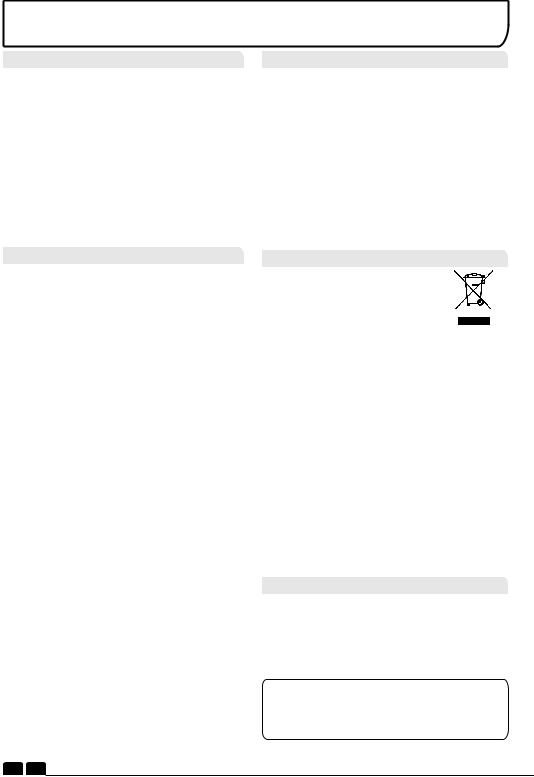
CONSIGLI DI SICUREZZA
Installazione |
Tutela dell’ambiente |
●Prima dell’uso, controllare che il prodotto non presenti segni visibili di danni. Non usare in caso di danni e contattare il Servizio Assistenza GIAS.
●Non utilizzare adattatori, connettori multipli e/o prolunghe.
●Non installare l’asciugatrice vicino ai tendaggi e rimuovere tempestivamente eventuali oggetti caduti dietro la macchina.
●L'apparecchio non deve essere installato dietro una porta che può essere chiusa a chiave, una porta scorrevole o una porta i cui cardini siano sul lato opposto rispetto a quelli dell'asciugatrice.
La Biancheria
●Non asciugare capi non lavati nell'asciugatrice.
●ATTENZIONE Evitare di asciugare articoli trattati con prodotti di pulizia a secco.
●ATTENZIONE In determinate circostanze, i materiali in gomma possono essere soggetti ad autocombustione se riscaldati. Articoli in gommapiuma (lattice), cuffie da doccia, tessuti impermeabili, articoli in caucciù e vestiti o cuscini imbottiti con gommapiuma NON VANNO asciugati nell'asciugatrice.
●Leggere attentamente le etichette con le istruzioni di lavaggio per conoscere le caratteristiche dell’asciugatura idonea.
●Gli indumenti devono essere introdotti nell’
a s c i u g a t r i c e s o l o d o p o e s s e r e s t a t i opportunamente centrifugati in lavatrice o strizzati a mano. EVITARE di caricare nel cestello indumenti ancora gocciolanti.
●Controllare accuratamente che nelle tasche degli indumenti da asciugare non siano presenti a c c e n d i n i o f i a m m i f e r i e d E V I TA R E ASSOLUTAMENTE l’uso di prodotti infiammabili in prossimità della macchina.
●Evitare ASSOLUTAMENTE di asciugare tende in fibra di vetro. La contaminazione dei capi con le fibre di vetro può infatti dar luogo a fenomeni d’irritazione cutanea.
●I capi che sono stati macchiati con sostanze come olio da cucina, acetone, alcol, petrolio, cherosene, smacchiatori, acquaragia, cere e sostanze per rimuovere le cere dovrebbero essere lavati in acqua calda con una quantità extra di detergente prima di essere asciugati nell'asciugatrice.
●Gli ammorbidenti o prodotti simili dovrebbero essere utilizzati come specificato nelle rispettive istruzioni.
●Tutti i materiali utilizzati per l’imballaggio sono ecologici e riciclabili. Smaltite l’imballaggio con metodi ecologici. Presso il comune di residenza si potranno reperire ulteriori informazioni sui metodi di smaltimento.
●Per garantire la sicurezza al momento dello smaltimento di una asciugatrice, scollegare la spina dell’alimentazione dalla presa, tagliare il cavo dell’alimentazione di rete e distruggerlo insieme alla spina. Per evitare che i bambini possano rimanere intrappolati all'interno della lavatrice, rompere i cardini o la chiusura dell’oblò.
Direttiva Europea 2002/96/CE
Questo elettrodomestico è marcato conformemente alla Direttiva Europea 2002/96/CE sui rifiuti da apparecchiature elettriche ed elettroniche (WEEE).
Assicurandovi che questo prodotto sia smaltito correttamente, aiuterete ad evitare possibili conseguenze negative all’ambiente e alla salute delle persone, che potrebbero verificarsi a causa d’un errato trattamento di questo prodotto giunto a fine vita.Il simbolo sul prodotto indica che questo apparecchio non può essere trattato come un normale rifiuto domestico; dovrà invece essere consegnato al punto più vicino di raccolta per il riciclo delle apparecchiature elettriche ed elettroniche. Lo smaltimento deve essere effettuato in accordo con le regole ambientali vigenti per lo smaltimento dei rifiuti.
Per informazioni più dettagliate sul trattamento, recupero e riciclo di questo prodotto, per favore contattare l’ufficio pubblico di competenza (del dipartimento ecologia e ambiente), o il vostro servizio di raccolta rifiuti a domicilio, o il negozio dove avete acquistato il prodotto.
Servizio GIAS
Ai fini della durata e del buon funzionamento della macchina, per gli eventuali interventi di assistenza o riparazione consigliamo di rivolgersi esclusivamente al servizio assistenza autorizzato GIAS.
 Nel caso in cui la macchina non funzioni correttamente o sia fuori uso, spegnere e staccare la spina dalla presa. Per la riparazione, rivolgersi al Centro Assistenza GIAS.
Nel caso in cui la macchina non funzioni correttamente o sia fuori uso, spegnere e staccare la spina dalla presa. Per la riparazione, rivolgersi al Centro Assistenza GIAS.
IT 16
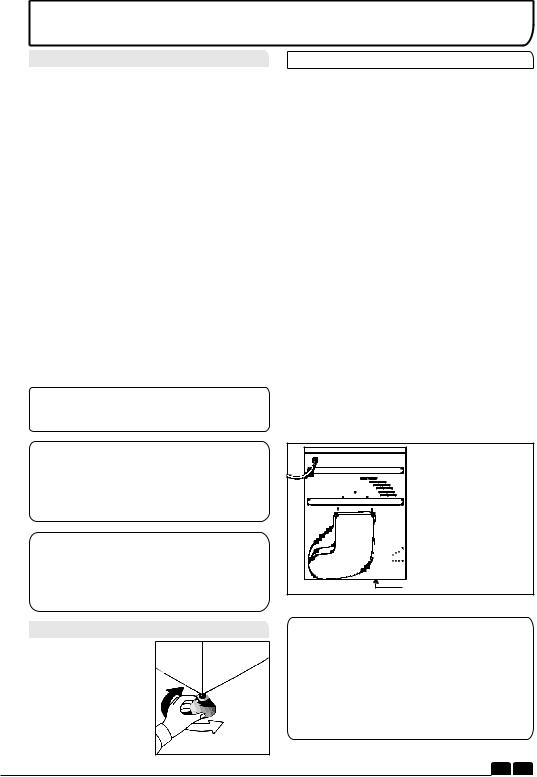
Requisiti Elettrici
Le asciugatrici sono state progettate per funzionare ad una tensione di 230V, 50 Hz m o n o f a s e . C o n t r o l l a r e c h e i l c i r c u i t o dell’alimentazione sia idoneo per valori di corrente di almeno 10A.
L’elettricità può essere estremamente pericolosa
L’apparecchio deve essere opportunamente
collegato a terra.
La presa e la spina dell’apparecchio devono
essere dello stesso tipo.
Non utilizzare adattatori multipli e/o
prolunghe.
Una volta completata l’installazione, la spina deve risultare accessibile e facilmente scollegabile.
L’apparecchio con marchio CE è conforme alle direttive europee 2004/108/CE, 2006/95/CE e successive modifiche.
 La chiamata può essere soggetta a pagamento, se le cause di malfunzionamento della macchina sono attribuibili a un’installazione non corretta.
La chiamata può essere soggetta a pagamento, se le cause di malfunzionamento della macchina sono attribuibili a un’installazione non corretta.
 Nel caso risulti danneggiato, il cavo di alimentazione dell’apparecchio dev’essere prontamente sostituito con apposito cavo reperibile ESCLUSIVAMENTE presso il servizio di ricambi. L’installazione deve essere effettuata da persone competenti.
Nel caso risulti danneggiato, il cavo di alimentazione dell’apparecchio dev’essere prontamente sostituito con apposito cavo reperibile ESCLUSIVAMENTE presso il servizio di ricambi. L’installazione deve essere effettuata da persone competenti.
 Non inserire la spina nella presa e non accendere la macchina finché l’installazione non sarà stata completata. Ai fini della sicurezza personale è essenziale che l’asciugatrice venga installata correttamente. In caso di dubbi sull’installazione, rivolgersi al Servizio Assistenza GIAS.
Non inserire la spina nella presa e non accendere la macchina finché l’installazione non sarà stata completata. Ai fini della sicurezza personale è essenziale che l’asciugatrice venga installata correttamente. In caso di dubbi sull’installazione, rivolgersi al Servizio Assistenza GIAS.
Regolazione dei Piedini
Una volta posizionata la macchina, si dovrebbe p r o c e d e r e a l l a regolazione dei piedini, p e r g a r a n t i r e u n a perfetta messa in bolla.
INSTALLAZIONE
VENTILAZIONE
Il locale in cui viene installata l’asciugatrice deve essere adeguatamente ventilato onde evitare che i gas provenienti da apparecchiature funzionanti con altri combustibili, comprese fiamme libere, siano aspirati nel locale dove l’asciugatrice è in funzione.
●Non scaricare l’ aria nella canna fumaria utilizzata per lo scarico di fumi provenienti da attrezzature funzionanti a gas o altri combustibili.
●Controllare periodicamente che attorno all’asciugatrice vi sia una buona circolazione d’aria, senza impedimenti di sorta.
●Dopo l’uso ispezionare il filtro antifilacce e, se necessario, pulirlo.
●Verificare costantemente che presa e sfiati non siano ostruiti. Per assicurare un’idonea ventilazione è essenziale che lo spazio tra il fondo macchina e il pavimento non sia ostruito. Tra la macchina ed eventuali ostacoli si dovrebbe lasciare uno spazio di almeno 12mm.
●Rimuovere tempestivamente eventuali oggetti caduti, dietro/sotto la macchina in quanto potrebbero ostruire le prese e gli sfiati dell’aria.
●EVITARE ASSOLUTAMENTE d’ installare la macchina contro tendaggi.
 PRESE ARIA
PRESE ARIA




 SFIATI ARIA
SFIATI ARIA
SFIATI ARIA NELLA BASE
 Non installare il prodotto in una stanza ove vi sia il rischio di formazione di ghiaccio. Alla temperatura di congelamento dell'acqua il prodotto potrebbe non funzionare correttamente. Se l'acqua del circuito idraulico ghiaccia sono possibili danni a componenti quali: valvole, pompe, tubi. Per garantire le prestazioni del prodotto la temperatura della stanza deve essere compresa tra +2°C e +35°C.
Non installare il prodotto in una stanza ove vi sia il rischio di formazione di ghiaccio. Alla temperatura di congelamento dell'acqua il prodotto potrebbe non funzionare correttamente. Se l'acqua del circuito idraulico ghiaccia sono possibili danni a componenti quali: valvole, pompe, tubi. Per garantire le prestazioni del prodotto la temperatura della stanza deve essere compresa tra +2°C e +35°C.
IT 17
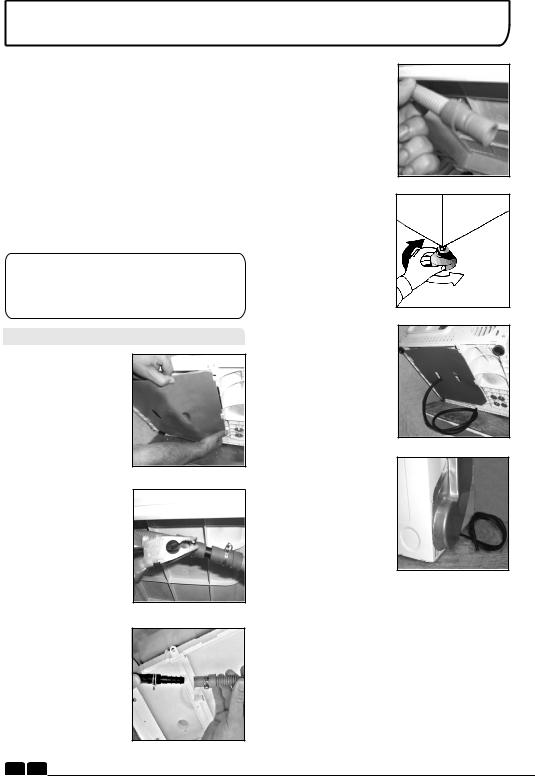
KIT ACCESSORIO TUBO FLESSIBILE DI SCARICO: ISTRUZIONI PER IL MONTAGGIO
Per evitare di dover svuotare il recipiente dell'acqua al termine di ciascun ciclo di essicazione, l'acqua normalmente raccolta può essere scaricata direttamente in un tubo di scarico dell'acqua di rifiuto (lo stesso sistema di scarico dei lavandini ad uso domestico). Le leggi locali sugli impianti idrici vietano il collegamento ad un sistema di scarico in superficie. Il sistema con il tubo di scarico dell'acqua di rifiuto deve essere situato accanto all'essiccatore a tamburo.
Il kit contiene: 1 tubo flessibile, 1 collare per tubi.
 AVVERTENZA! Spegnere e togliere la spina dell'essiccatore dalla presa di alimentazione elettrica prima di eseguire qualsiasi operazione.
AVVERTENZA! Spegnere e togliere la spina dell'essiccatore dalla presa di alimentazione elettrica prima di eseguire qualsiasi operazione.
Montare il Kit Come Indicato di Seguito:
1.Inclini la macchina all'indietro.
2.Rimuova il pannello
i n f e r i o r e d e l l a protezione, tirando con attenzione nella parte di sinistra.
3. Il tubo delle acque di rifiuto è situato sul lato destro della macchina (vedi l'immagine) . Utilizzando un paio di pinze, togliere il collare di fissaggio del tubo dal ponte che si trova più vicino al lato posteriore della macchina.
4. Estrarre il tubo flessibile dal raccordo del ponte.
5 . U t i l i z z a n d o i l raccordo e i collari per tubi in dotazione, c o l l e g a r e i l t u b o flessibile nero del kit al tubo precedentemente rimosso dal raccordo del ponte.
6.Inserire il tappo per c h i u d e r e i l t u b o flessibile rimanente.
7.Inserisca il tubo flessibile di scolo attraverso il foro nel pannello inferiore della protezione.
8.Faccia scorrere con
attenzione il pannello i n f e r i o r e d e l l a p r o t e z i o n e nuovamente dentro la p o s i z i o n e accertandosi che il tubo flessibile non sia bloccato.
9. Accertarsi che il nuovo tubo flessibile non si attorcigli sui p i e d i n i m e n t r e l a macchina viene spinta nella sua posizione d'origine.
10. Colleghi il nuovo tubo flessibile di scolo al tubo delle acque di rifiuto.
11. Collegare alla p r e s a d i alimentazione.
IT 18
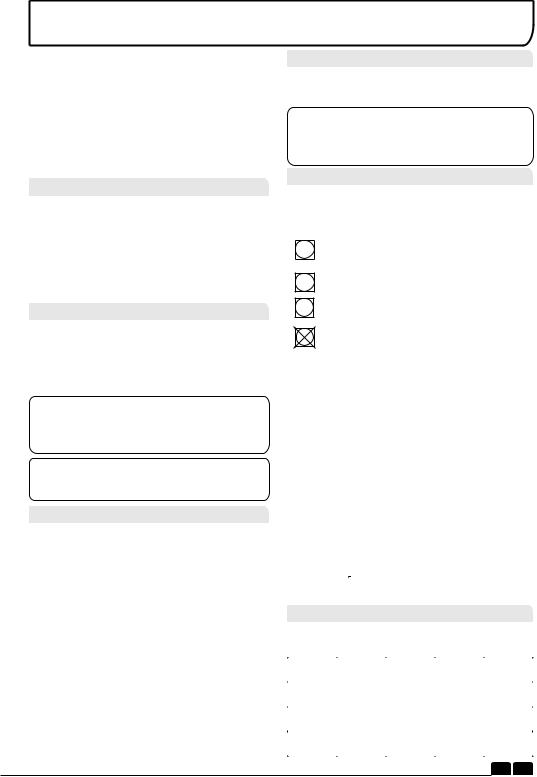
PREPARAZIONE DELLA BIANCHERIA
Prima di utilizzare l’asciugatrice per la prima volta:
●Leggere attentamente il presente libretto d’istruzioni.
●Togliere tutti gli articoli presenti all’ interno del cestello.
●Pulire l’interno del cestello e il portellone con un panno umido in modo da eliminare l’eventuale polvere depositata durante il trasporto.
Preparazione dei Capi
Verificare che la biancheria da asciugare sia idonea per l’asciugatura meccanica, come indicato dai simboli sull’etichetta di lavaggio dei vari articoli.
Controllare che le chiusure siano chiuse e le tasche vuote. Girare i capi con il rovescio all’esterno. Introdurre i capi nel cestello uno ad uno, in modo che non si aggroviglino.
Evitare Di Asciugare:
Articoli di lana, seta, tessuti delicati, calze di nylon,ricami delicati, tessuti con decorazioni metalliche, indumenti con guarnizioni in PVC o in pelle, scarpe da ginnastica, articoli pesanti come sacchi a pelo ecc.
 IMPORTANTE: Evitare di asciugare articoli preventivamente trattati con prodotti di pulizia a secco o capi in gomma (pericolo d’incendio o esplosione).
IMPORTANTE: Evitare di asciugare articoli preventivamente trattati con prodotti di pulizia a secco o capi in gomma (pericolo d’incendio o esplosione).
Durante gli ultimi 15 minuti (approssimativamente) i capi sono sempre asciugati con aria fredda.
Risparmio Energia
Introdurre nell’asciugatrice solo biancheria accuratamente strizzata a mano o centrifugata a macchina. Quanto più asciutta è la biancheria, tanto più rapido è il tempo richiesto per l’asciugatura, con conseguente risparmio di consumo elettrico.
COSA FARE SEMPRE
●Cercare sempre di far lavorare la macchina a pieno carico di biancheria: si risparmia tempo ed elettricità.
●Prima di ogni ciclo di asciugatura verificare SEMPRE che il filtro sia pulito.
COSA NON FARE MAI
●Non superare mai il peso massimo: si perde tempo e si consuma più elettricità.
●Evitare di caricare capi ancora gocciolanti: si rischia di rovinare la macchina.
Peso Massimo di Asciugatura
● |
Capi in cotone |
Max. 8 kg |
● |
Capi sintetici |
Max. 4 kg |
 Non sovraccaricare il cestello, in quanto I capi ingombranti, a caldo, possono superare il carico massimo consentito. (per esempio sacchi a pelo e piumoni)
Non sovraccaricare il cestello, in quanto I capi ingombranti, a caldo, possono superare il carico massimo consentito. (per esempio sacchi a pelo e piumoni)
Selezionare La Biancheria Nel Modo Seguente:
●In base ai simboli delle etichette di lavaggio
Le etichette di lavaggio sono apposte sul collo o sulle cuciture interne:
Articolo idoneo per l’asciugatura meccanica.
. . Asciugatura ad alta temperatura.
. Solo asciugatura a bassa temperatura.
Articolo non idoneo all’asciugatura meccanica.
Se il capo è sprovvisto di etichetta di lavaggio, si deve presumere che non sia idoneo all’asciugatura meccanica.
●In base al quantitativo ed alla pesantezza
Se il carico è superiore alla capacità della macchina, separare i capi in base alla pesantezza (p. es., separare gli asciugamani dalla biancheria leggera).
●In base al tipo di tessuto
Articoli di cotone/lino: Asciugamani, jersey di cotone, biancheria da tavola/letto.
Articoli sintetici: Camicette, camicie, tute ecc. in poliestere o poliammide e misti cotone/sintetici.
●In base al grado di asciugatura
Selezionare tra: capi asciutti da stirare, capi pronti da riporre ecc. Per i capi delicati premere il pulsante  ,impostando una temperatura di asciugatura ridotta.
,impostando una temperatura di asciugatura ridotta.
Guida Ad Una Corretta Asciugatura
In tabella sono riportati i tempi di asciugatura indicativi in funzione del tipo di tessuto e del grado di umidità dei capi.
TESSUTO |
SELEZIONE |
CARICO |
CARICO |
CARICO |
|
TEMPE. |
PESANTE |
MEDIO |
LEGGERO |
COTONE |
ELEVATA |
140-165min |
70-80min |
50-65min |
|
|
|
|
|
SINTETICI |
BASSA |
--- |
70-80min |
40-55min |
|
|
|
|
|
ACRILICI |
BASSA |
--- |
50-65min |
30-40min |
|
|
|
|
|
IT 19
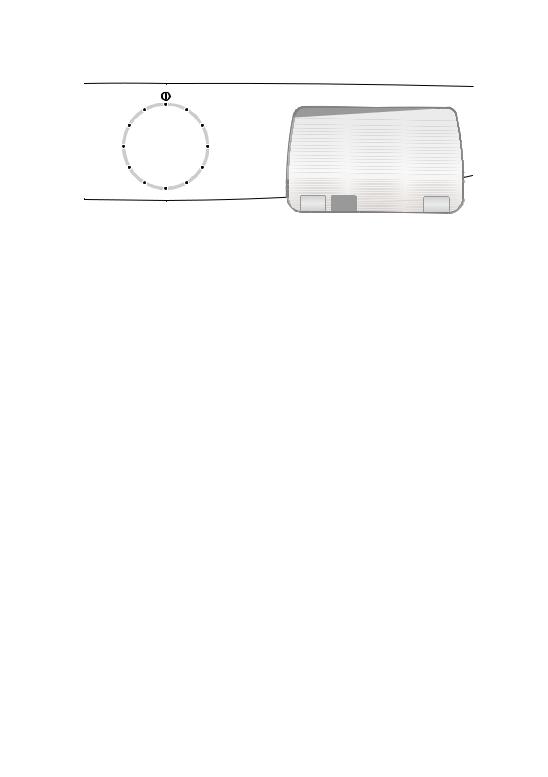
COMANDI E SPIE DI SEGNALAZIONE
Selettore |
Spia Elimina |
Spia Pulizia |
Display Programmi |
Tasto |
Programmi |
Acqua |
Filtro |
Automatici |
Avvio/pausa |
Pulsante |
Pulsante Partenza |
Pulsante |
Pulsante |
|||
Selezione Tempo |
|
Ritardata |
Acrilici/Sintetici |
Anti Piega |
||
Pannello di Comando e Spie Luminose |
|
|
|
|
||
Selettore dei programmi – Consente di selezionare il programma desiderato. |
|
|||||
Pulsante Selezione Tempo |
– Consente |
di modificare la durata del programma scelto. Può |
||||
essere usato solo con il programma : Mix&Dry, Camicie e con i Programmi a tempo. |
||||||
Tasto Partenza Ritardata |
– Consente all'utente di ritardare la partenza del ciclo di asciugatura ( |
|||||
vedere i dettagli nella sezione specifica). |
|
|
|
|
|
|
Pulsante Acrilici/Sintetici – Se il pulsante viene premuto, la spia |
si spegne e si |
|||||
Accende la  .
.
Pulsante Anti Piega  – Consente all'utente di programmare un ciclo anti piega a fine ciclo. Pulsante Avvio/Pausa
– Consente all'utente di programmare un ciclo anti piega a fine ciclo. Pulsante Avvio/Pausa  –Per dare inizio o fermare il programma selezionato.
–Per dare inizio o fermare il programma selezionato.
Pulsante Memo – Dopo 2 minuti di avvio di un programma ed eventuali opzioni, è possibile premendo simultaneamente per 3 secondi i pulsanti Anti Piega e Acrilici/Sintetici, memorizzare il programma preferito.
Spia di pulizia filtro  – Si accende quando il filtro necessita di essere pulito
– Si accende quando il filtro necessita di essere pulito
Spia elimina acqua – Si accende quando il contenitore dell'acqua di condensa è pieno. Display Programmi Automatici – Le relative spie luminose di accendono quando un programma automatico è stato selezionato.
- La spia si illuminerà quando un programma ecologico verrà selezionato.
Refresh  – La spia si accende quando il programma inizia la fase di raffreddamento.
– La spia si accende quando il programma inizia la fase di raffreddamento.
SELEZIONE DEL PROGRAMMA
La macchina dotata di sensore di asciugatura, offre opzioni di asciugatura in grado di rispondere alle più svariate esigenze.
Nella tabella che segue viene riportato un elenco dei programmi con la relativa funzione.
Nota: il sensore potrebbe non essere in grado di individuare un carico ridotto di articoli di piccole dimensioni. Per carichi ridotti e articoli separati o per tessuti pre-asciugati leggermente umidi, selezionare i programmi a tempo.
Impostare il tempo del programma tra 30 e 75 minuti in base alla quantità del carico e al grado di asciugatura richiesto. Successivamente, selezionare la temperatura alta o bassa in base al tipo di tessuto.
Se il sensore non rileva la presenza del capo, l’asciugatrice funziona solo per 10 minuti,prima di passare alla fase di raffreddamento.
Se il carico è troppo abbondante o troppo bagnato per essere asciugato, l’asciugatrice passa automaticamente alla fase di raffreddamento dopo circa 3 ore.
IT 20

SELEZIONE DEL PROGRAMMA
PROGRAMMA |
DESCRIZIONE |
|
|
|
|
Capi Completamente |
Selezionare il grado di asciugatura desiderato. Le possibilità |
|
Asciutti |
||
Capi Extra Asciutti |
disponibili comprendono l’opzione , ideale per asciugamani e |
|
|
accappatoi, l’opzione , per i capi che non è necessario stirare, e i |
|
Capi Asciutti Da Riporre |
||
|
programmi che lasciano la biancheria pronta per la stiratura. |
|
Capi Asciutti Da Stirare |
||
|
||
|
|
|
Relax |
Il programma assicura una funzione di trattamento antipiega. La |
|
|
macchina effettua un ciclo di riscaldamento della biancheria per 9 |
|
|
minuti, seguito da 3 minuti di raffreddamento. Si tratta di una |
|
|
funzione particolarmente utile quando si prevede di riporre la |
|
|
biancheria (ad esempio, nel cesto della biancheria) per un periodo |
|
|
di tempo prima della stiratura. I capi possono “seccarsi” |
|
|
eccessivamente anche quando vengono fatti asciugare all’aperto |
|
|
sul filo o vengono posti su radiatori. Il Ciclo attenua le pieghe sul |
|
|
tessuto rendendo più facile e più rapida la stiratura. |
|
Lana |
Un programma delicato creato appositamente per ottenere capi |
|
in lana più soffici dopo l’asciugatura ad aria. |
||
|
||
|
Questo ciclo delicato con aria calda, della durata di 12 minuti, si |
|
|
può utilizzare anche per infrescare i capi in lana dopo averli |
|
|
tenuti in guardaroba. |
|
Mix & Dry |
Questo è uno speciale programma a tempo per l’asciugatura di |
|
massimo 4 Kg di bucato (117 minuti). Di base, la durata di |
||
|
||
|
asciugatura suggerita è di 99 minuti e permette di asciugare 3 Kg. |
|
|
C o n q u e s t o p r o g r a m m a è p o s s i b i l e a s c i u g a r e |
|
|
contemporaneamente fibre in cotone e fibre sintetiche. |
|
Camicie |
Questo è uno speciale programma a tempo per l’asciugatura di |
|
camicie con un carico massimo di 3 Kg (78 minuti). Per camicie o |
||
|
||
|
maglie sintetiche è possibile pressare il pulsante Acrilici/Sintetici. |
|
|
Di base la durata del ciclo suggerito dalla macchina è di 60 minuti e |
|
|
consente di asciugare fino a 2 kg di carico. |
|
|
|
|
Rapid 40' |
Con il programma Rapid 40’, il ciclo di asciugatura è completato |
|
|
rapidamente. E’ ideale se si vogliono capi asciutti, rinfrescati e pronti |
|
|
da indossare in circa 40 minuti. Questo speciale programma |
|
|
monitora continuamente la temperatura nel cesto. Il massimo carico |
|
|
consentito è 2 Kg e il programma è adatto a qualsiasi tipo di fibra che |
|
|
in genere può essere asciugata con questo apparecchio. |
|
|
|
|
Time |
Include tutti i programmi a tempo manuali: da 30 a 180 minuti. La |
|
|
selezione del programma a tempo di 20 minuti prevede solo un |
|
|
ciclo di ventilazione con aria fredda (Refresh). |
|
|
|
|
Memo |
Consente di riproporre un programma che è stato |
|
|
precedentemente memorizzato, senza il bisogno di ri-selezionarlo |
|
|
sulla manopola e di scegliere una eventuale opzione con uno dei |
|
|
pulsanti. |
|
|
|
IT 21

PORTELLONE e FILTRO
Apertura del Portellone
Tirare la maniglia per aprire lo sportello.
P e r a v v i a r e l a macchina, richiudere i l p o r t e l l o n e e premere il tasto. 
 AVVERTENZA! Si ricorda che quando la macchina è in funzione il cestello e il portellone possono essere MOLTO CALDI. Non arrestare mai l'asciugatrice prima della fine del ciclo di asciugatura a meno che tutti i capi in essa contenuti non vengano rimossi rapidamente e stesi in modo da dissipare il calore.
AVVERTENZA! Si ricorda che quando la macchina è in funzione il cestello e il portellone possono essere MOLTO CALDI. Non arrestare mai l'asciugatrice prima della fine del ciclo di asciugatura a meno che tutti i capi in essa contenuti non vengano rimossi rapidamente e stesi in modo da dissipare il calore.
Filtro
IMPORTANTE: Ai fini della massima efficacia della macchina, prima di ogni ciclo di asciugatura è essenziale verificare la pulizia del filtro antifilacce.
1. Tirare il filtro verso l’alto.
2. Aprire il filtro come illustrato.
3 . R i m u o v e r e delicatamente le filacce con la punta delle dita o aiutandosi con uno spazzolino morbido.
4. Richiudere il filtro e reinserirlo in sede.
Spia Di Pulizia Filtro
 s i a c c e n d e s e g n a l a n d o l a necessità di pulire il filtro.
s i a c c e n d e s e g n a l a n d o l a necessità di pulire il filtro.
Se la biancheria non si asciuga verificare che il filtro non sia intasato.
NON USARE ACQUA PER PULIRE IL FILTRO
VASCHETTA DELL’ACQUA
L'acqua eliminata dalla biancheria durante il ciclo di asciugatura viene raccolta in una vaschetta posta all'interno della porta della macchina. Quando la vaschetta è piena si accende la spia  sul pannello dei comandi, segnalando che si DEVE vuotare la vaschetta. Tuttavia, si consiglia di svuotare la vaschetta dopo ogni ciclo di asciugatura.
sul pannello dei comandi, segnalando che si DEVE vuotare la vaschetta. Tuttavia, si consiglia di svuotare la vaschetta dopo ogni ciclo di asciugatura.
NOTA: Nei primi cicli, quando la macchina è nuova, si raccoglie poca acqua in quanto si riempie prima il serbatoio interno.
Poista Säiliö Seuraavasti
1. E s t r a r r e c o n d e l i c a t e z z a l a vaschetta, a f f e r r a n d o l a d a l l a maniglia. Da piena, la vaschetta dell'acqua pesa circa 6 kg.
2. Inclinare la vaschetta f a c e n d o d e f l u i r e l ' ac q u a d a l beccuccio. Quando è vuota, riporre la vaschetta nell'alloggio come indicato; prima inserire la base della v a s c h e t t a e p o i gentilmente premere la p a r t e s u p e r i o r e nell'apposita sede.
3. Premere il pulsante  per riavviare il ciclo.
per riavviare il ciclo.
NOTA: Se c'è uno s c a r i c o v i c i n o all'asciugatrice, si può usare l'apposito kit per f a r s c a r i c a r e costantemente l'acqua r a c c o l t a d a l l a m a c c h i n a . C o s ì facendo si eviterà di svuotare la vaschetta
dell'acqua. 1
 A T T E N Z I O N E ! S e l a p o r t a dell'asciugabiancheria viene aperta durante il ciclo, prima quindi che sia completata la fase di raffreddamento, la maniglia della vaschetta può essere molto calda. Fare attenzione e usare la massima cautela nel maneggiare vaschetta se la si vuole svuotare.
A T T E N Z I O N E ! S e l a p o r t a dell'asciugabiancheria viene aperta durante il ciclo, prima quindi che sia completata la fase di raffreddamento, la maniglia della vaschetta può essere molto calda. Fare attenzione e usare la massima cautela nel maneggiare vaschetta se la si vuole svuotare.
IT 22
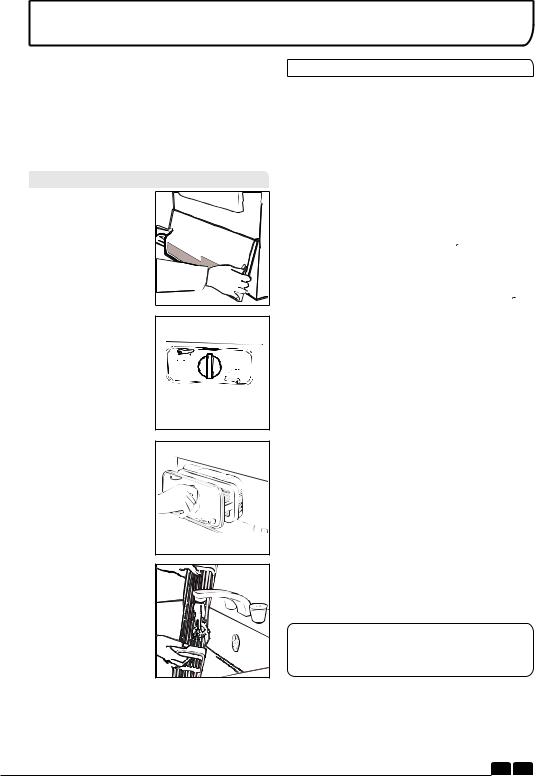
CONDENSATORE
IMPORTANTE: Prima di procedere alla pulizia del condensatore, disattivare sempre l’apparecchio e staccare la spina dalla presa elettrica.
Ai fini delle prestazione dell’apparecchio, è opportuno verificare regolarmente lo stato di pulizia del condensatore.
Per Togliere Il Condensatore
1 . R i m u o v e r e l o zoccolo.
2. Agire sulle due leve di bloccaggio in senso antiorario e estrarre il condensatore.
3.Estrarre il modulo condensatore.
4.Servendosi di un p a n n o , e l i m i n a r e delicatamente polvere e filacce, poi lavare il modulo tenendolo sotto l’acqua corrente e facendolo girare in modo che l’acqua circoli tra le piastre fino a perfetta eliminazione delle impurità
5 . R i m o n t a r e i l |
||
c o n d e n s a t o r e |
||
rispettando |
il |
verso |
giusto (come |
indicato |
|
d a l l a f r e c c i a ) e |
||
accertandosi |
che sia |
|
perfettamente |
inserito |
|
in sede. Bloccare le |
||
due leve ruotandole in |
||
senso orario. |
|
|
6 . R i m o n t a r e l o |
||
zoccolo. |
|
|
FUNZIONAMENTO
1.Aprire la porta e caricare la biancheria nel cesto. Assicurarsi che i capi non si incastrino nella porta.
2.Chiudere gentilmente la porta fino a sentire un “click”.
3.Ruotare il selettore programmi e scegliere il programma di asciugatura desiderato (per dettagli, guardare la Guida Programmi).
4.Se bisogna asciugare tessuti sintetici, acrilici o delicati, premere il pulsante  per ridurre la temperatura di asciugatura. La spia si illumina
per ridurre la temperatura di asciugatura. La spia si illumina
quando si sceglie questa opzione. Per de-
selezionarla, nei primi minuti di avvio del programma, ri-premere il pulsante  e programmare nuovamente la macchina.
e programmare nuovamente la macchina.
5.Premere il pulsante . L’asciugabiancheria inizia automaticamente e la spia luminosa
. L’asciugabiancheria inizia automaticamente e la spia luminosa
sopra il tasto resta accesa.
6.Se si apre la porta durante il ciclo per controllare la biancheria, è necessario successivamente richiudere la porta e premere
il pulsante  , il ciclo di asciugatura ricomincerà nuovamente.
, il ciclo di asciugatura ricomincerà nuovamente.
7.Quando il ciclo è prossimo alla fine, inizia una fase di raffreddamento. I capi vengono asciugati con aria fredda al fine di raffreddarli.
8.Quando il programma è terminato, la spia END si illumine sul display.
9.A seguito della fine del ciclo, il cesto effettuerà delle rotazioni ad intermittenza per minimizzare le pieghe. Continuerà fino a quando la porta verrà aperta.
 Non aprire la porta durante i cicli di asciugatura automatici per avere un'asciugatura sempre efficace.
Non aprire la porta durante i cicli di asciugatura automatici per avere un'asciugatura sempre efficace.
IT 23

FUNZIONAMENTO
Partenza Ritardata
La funzione Partenza Ritardata  consente all’utente di ritardare la partenza del ciclo di asciugatura da 1 a 24 ore.
consente all’utente di ritardare la partenza del ciclo di asciugatura da 1 a 24 ore.
Agendo la prima volta sul tasto di questa funzione, comparirà sul display un ritardo di 1 ora, a ogni successiva pressione del tasto, si aggiungerà un ulteriore ritardo di 1 ora.
Successivamente, premere il tasto  e trascorso il tempo di ritardo selezionato, il ciclo di asciugatura verrà avviato. La spia luminosa lampeggerà indicando che count down è iniziato.
e trascorso il tempo di ritardo selezionato, il ciclo di asciugatura verrà avviato. La spia luminosa lampeggerà indicando che count down è iniziato.
Annullamento e Azzeramento Del Programma
Per cancellare il programma premere il pulsante  per 3 secondi. Nel display “TIME CONTROL” lampeggerà 0:00 indicando che è stato azzerato il programma.
per 3 secondi. Nel display “TIME CONTROL” lampeggerà 0:00 indicando che è stato azzerato il programma.
PULIZIA E MANUTENZIONE ORDINARIA
Pulizia dell’asciugatrice
●Si consiglia di pulire il filtro e di svuotare la vaschetta dell’acqua dopo ogni ciclo di asciugatura.
●Pulire regolarmente il condensatore.
●Dopo l’ uso, pulire l’ interno del cestello e lasciare aperto il portellone per un certo periodo di tempo in modo che circoli aria e si asciughi.
●Pulire l’esterno della macchina e il portellone con un panno morbido.
●NON usare spugnette abrasive né prodotti di pulizia.
●Pre evitare che si accumuli della lanuggine e che l'oblò abbia difficoltà ad aprirsi/chiudere, a fine di ogni ciclo d'asciugatura pulire con un panno umido la parte interna dell'oblò e la guarnizione.
 AVVERTENZA! Il cestello, il portellone e il carico possono essere molto caldi.
AVVERTENZA! Il cestello, il portellone e il carico possono essere molto caldi.
Specifiche Tecniche
Capacità del cestello |
115 litri |
Carico massimo |
8 kg |
Altezza |
85 cm |
Larghezza |
60 cm |
Profondità |
60 cm |
Efficienza Energetica |
B |
Informazıonı per Test dı Laboratorıo
EN 61121 Programmı |
Programmı da usare |
-Cotone Asciutto |
-Capi Asciutti da Riporre |
-Cotone Asciutto da Stirare |
-Capi Asciutti da Stirare |
-Tessuti Delicati |
-Capi Asciutti da Riporre |
|
+Sintetico |
 IMPORTANTE Prima di procedere alla pulizia, disattivare sempre la macchina e staccare la spina dalla presa a muro.
IMPORTANTE Prima di procedere alla pulizia, disattivare sempre la macchina e staccare la spina dalla presa a muro.
 Per i dati elettrici vedere la targhetta dei dati posta sul davanti del mobile della macchina (con portellone aperto).
Per i dati elettrici vedere la targhetta dei dati posta sul davanti del mobile della macchina (con portellone aperto).
IT 24

Quale Può Essere La Causa...
Problemi che può risolvere l’utente
Prima di rivolgersi al Centro Assistenza GIAS, consultare la seguente checklist. La chiamata verrà addebitata all'utente nel caso in cui risulti che la macchina funziona o è stata installata o utilizzata in maniera errata. Se il problema persiste anche dopo aver eseguito i controlli consigliati, rivolgersi al servizio di assistenza GIAS che sarà a disposizione per suggerire eventuali soluzioni per telefono.
Il tempo di asciugatura residuo può variare durante il ciclo. Il tempo infatti viene costantemente aggiornato per migliorarne la stima. E' per tanto normale che durante il ciclo, il tempo mostrato sul display possa aumentare o diminuire.
Tempo di asciugatura eccessivamente lungo/capi non sufficientemente asciutti…
●Il programma/tempo di asciugatura selezionato è corretto?
●I capi sono stati introdotti eccessivamente bagnati? Si è provveduto a strizzare o centrifugare adeguatamente i capi prima d’introdurli nella macchina?
●Si deve pulire il filtro?
●Si deve pulire il condensatore?
●L’asciugatrice è stata caricata eccessivamente?
●Vi sono ostruzioni a livello delle prese, degli sfiati e della base dell’asciugatrice?
●Il tasto  è stato selezionato da un ciclo precedente?
è stato selezionato da un ciclo precedente?
L’asciugatrice non funziona…
●L’alimentazione elettrica cui è collegata la macchina è attiva? Controllare provando con un altro apparecchio (ad esempio, lampada da tavolo).
●La spina di alimentazione è stata collegata correttamente all’alimentazione elettrica?
●Manca la corrente?
●Fusibile bruciato?
●Il portellone è stato chiuso perfettamente?
●La macchina è stata opportunamente attivata (sia collegata all’alimentazione sia attivata localmente)?
●È stato selezionato il tempo o il programma di asciugatura?
●La macchina è stata riattivata dopo aver aperto il portellone?
●La macchina ha smesso di funzionare perché la vaschetta dell’acqua è piena e deve essere svuotata?
RICERCA GUASTI
L’asciugatrice fa molto rumore…
● Spegnere l’asciugatrice e rivolgersi al Servizio
Assistenza GIAS.
La spia di segnalazione  è accesa…
è accesa…
●Si deve pulire il filtro?
●Si deve pulire il condensatore?
La spia di segnalazione  è accesa…
è accesa…
● Si deve svuotare la vaschetta dell’acqua?
SERVIZIO ASSISTENZA CLIENTI
Se il problema persiste anche dopo aver effettuato tutti icontrolli consigliati, rivolgersi al Servizio Assistenza GIAS.
Sarà a disposizione per suggerire eventuali soluzioni per telefono o per fissare la visita del tecnico in base alle condizioni di garanzia. Si ricorda che l’intervento del tecnico può essere soggetto a pagamento nel caso la macchina:
●risulti perfettamente funzionante.
●non sia stata installata secondo quanto indicato nelle istruzioni d’installazione.
●sia stata utilizzata in modo improprio.
Ricambi
Utilizzare sempre ricambi originali, disponibili direttamente presso il Servizio Assistenza GIAS.
Servizio GIAS
Per assistenza e riparazioni, rivolgersi al tecnico del Servizio Assistenza GIAS più vicino.
Il produttore declina ogni responsabilità in caso di eventuali errori di stampa nel presente opuscolo. Il produttore si riserva il diritto di apportare le necessarie modifiche ai propri prodotti, senza alterarne le caratteristiche essenziali.
IT 25
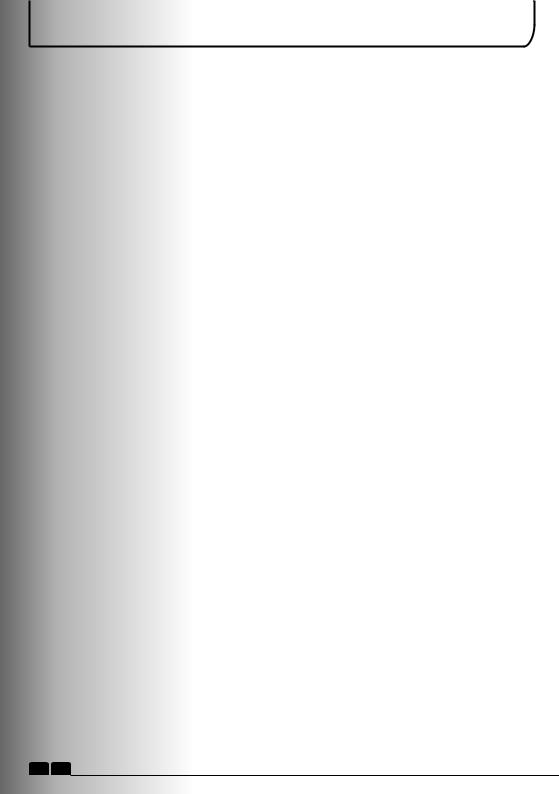
INDEX
Einführung |
27 |
Lieferinformationen |
27 |
Auspacken des Produkts |
27 |
Sicherheitshinweise |
27 |
Gebrauch |
27 |
Installation |
28 |
Die Wäsche |
28 |
Umweltschutz |
28 |
GIAS-Service |
28 |
Installation |
29 |
Elektro-Anschluss |
29 |
Einstellen der Füße |
29 |
Entlüftung |
29 |
Ablaufschlauchbausatz: Installationsanleitung |
30 |
Vorbereitung der Füllung |
31 |
Vorbereitung der Textilien |
31 |
Nicht für den Trockner geeignet |
31 |
Energiesparen |
31 |
Sortierung der Füllung |
31 |
Trocknungswerte |
31 |
Schalterblende und Anzeigen |
32 |
Auswählen des Programms |
33 |
Tür und Sieb |
34 |
Öffnen der Tür |
34 |
Sieb |
34 |
Flusensieb-Anzeige |
34 |
Kondenswasser-Behälter |
34 |
Um den Behälter herauszunehmen |
34 |
Kondensator |
35 |
Entfernen des Kondensators |
35 |
Betrieb |
35 |
Startverzögerung |
36 |
Abbrechen und Zurücksetzen des Programms |
36 |
Reinigung und Routinewartungen |
36 |
Reinigung des Trockners |
36 |
Technische Daten |
36 |
Fehlersuche |
37 |
Kundendienst |
37 |
Ersatzteile |
37 |
GIAS-Service |
37 |
DE 26
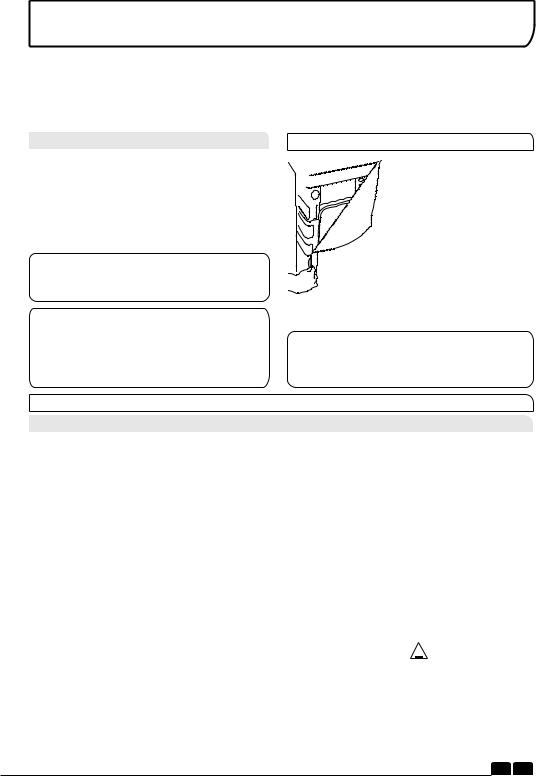
EINFÜHRUNG
Bitte lesen Sie diese Anleitung sorgfältig durch und richten Sie sich bei der Bedienung der Waschmaschine an die Anleitung. Dieses Handbuch enthält wichtige Hinweise für die sichere Installation, Anwendung und Wartung sowie einige nützliche Hinweise für optimale Ergebnisse beim Gebrauch Ihrer Maschine.
Heben Sie diese Dokumentation an einem sicheren Ort auf, um jederzeit wieder darauf zurückgreifen zu können bzw. um sie an zukünftige Besitzer weitergeben zu können
Liefer informationen
Zum Lieferumfang Ihrer Waschmaschine gehören folgende Dokumentation und Zusatzteile:
●Bedienungsanleitung
●Garantieschein
●Energieeffizienzklasse
 Kontrollieren Sie,ob die Maschine durch den Transport beschädigt wurde.Falls dies der Fall ist, wenden Sie sich an den GIASService.
Kontrollieren Sie,ob die Maschine durch den Transport beschädigt wurde.Falls dies der Fall ist, wenden Sie sich an den GIASService.
 Die Sicherheit des Geräts kann beeinträchtigt werden, wenn Sie sich nicht an diese Sicherheitshinweis e halten. Falls ein Problem mit Ihrer Maschine durch Zweckentfremdung verursacht wird, müssen Sie Reparaturarbeiten möglicherweise selbst bezahlen.
Die Sicherheit des Geräts kann beeinträchtigt werden, wenn Sie sich nicht an diese Sicherheitshinweis e halten. Falls ein Problem mit Ihrer Maschine durch Zweckentfremdung verursacht wird, müssen Sie Reparaturarbeiten möglicherweise selbst bezahlen.
AUSPACKEN DES PRODUKTS
E n t f e r n e n S i e d i e Verpackung der Maschine dicht an dem Platz, wo sie aufgestellt werden soll.
1. Schneiden Sie sie sorgfältig rund um den Boden der Verpackung und an einer Ecke nach oben auf.
2 . E n t f e r n e n S i e d i e Polyethylenhülle und heben Sie den Trockner von der Polystyrenplatte.
 E n t s o r g e n S i e d i e V e r p a c k u n g ordnungsgemäß. Achten Sie darauf, dass sie nicht in die Hände von Kindern gelangt,da sie eine potentielle Gefahrenquelle darstellt.
E n t s o r g e n S i e d i e V e r p a c k u n g ordnungsgemäß. Achten Sie darauf, dass sie nicht in die Hände von Kindern gelangt,da sie eine potentielle Gefahrenquelle darstellt.
SICHERHEITSHINWEISE
Gebrauch
●Dieses Gerät ist nicht für den Gebrauch durch Personen mit eingeschränkten körperlichen, sensorischen oder mentalen Fähigkeiten oder mangelnder Erfahrung und Wissen (beispielsweise Kindern) gedacht, außer diese werden beaufsichtigt oder wurden über die Verwendung des Geräts von einer Person unterrichtet, die für ihre Sicherheit verantwortlich ist.
●Kinder sollten beaufsichtigt werden, um sicherzustellen, dass sie nicht mit dem Gerät spielen.
●WARNUNG Zweckentfremdung des Trockners kann zu Brandgefahr führen.
●Diese Maschine dient als Haushaltsgerät ausschließ lich zum Trocknen von Haushaltstextilien und Kleidungsstücken.
●Verwenden Sie dieses Gerät nur für die vorgesehenen Zwecke gemäß der Anleitung. Lesen Sie die Gebrauchsanleitung sorgfältig durch, bevor Sie das Gerät in Betrieb nehmen.
●Berühren Sie das Gerät nicht mit feuchten oder nassen Händen oder Füßen.
●Lehnen Sie sich nicht gegen die Tür, wenn Sie die Maschine beladen, und fassen Sie die Maschine nicht an der Tür, wenn Sie sie hochheben oder verschieben.
●Lassen Sie Kinder nicht mit der Maschine oder den Schaltern spielen.
●WARNUNG Verwenden Sie das Produkt nicht, wenn das Flusensieb nicht richtig eingebaut oder beschädigt ist; Flusen könnten Feuer fangen.
●WARNUNG An der Stelle, an der sich das Symbol für heiße Flächen befindet  ,kann die Temperatur während des Trocknerbetriebs auf über 60°C steigen.
,kann die Temperatur während des Trocknerbetriebs auf über 60°C steigen.
●Ziehen Sie den Stecker aus der Steckdose! Ziehen Sie vor dem Reinigen des Geräts immer den Stecker heraus!
●Verwenden Sie die Maschine bei vermuteten Störungen nicht weiter.
●Fusseln und Flusen dürfen sich nicht auf dem Fußboden im Bereich um die Maschine ansammeln.
●Die Trommel in dem Gerät kann sehr heiß werden. Lassen Sie den Trockner stets vollständig bis zum Ende der Abkühlphase laufen, bevor Sie die Wäsche herausnehmen.
DE 27
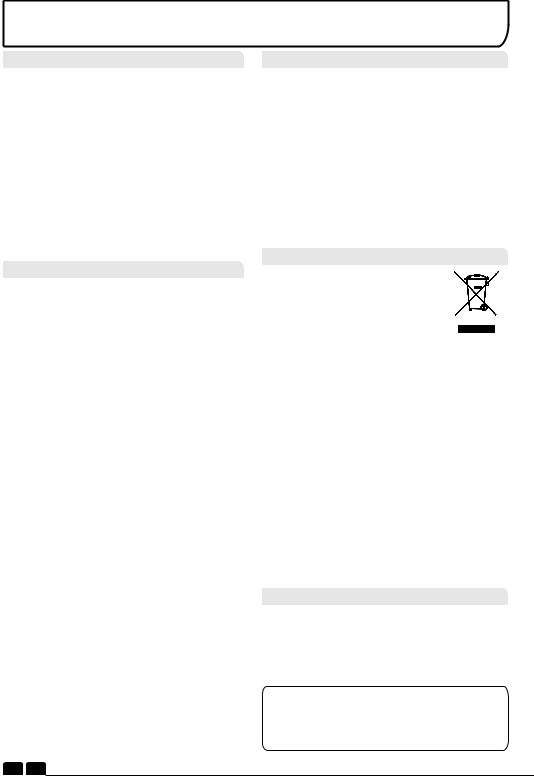
SICHERHEITSHINWEISE
Installation
●Überprüfen Sie vor dem Gebrauch, ob das Produkt sichtbare Schäden aufweist. Verwenden Sie es nicht, wenn es beschädigt ist, und wenden Sie sich an den GIAS-Service.
●Verwenden Sie keine Adapter, Mehrfachsteck dosen und/oder Verlängerungskabel.
●Stellen Sie den Trockner nie in der Nähe von Vorhängen auf. Achten Sie darauf, dass keine Gegenstände hinter den Trockner fallen oder sich dort ansammeln können.
●Das Gerät darf nicht hinter einer verschließ baren Tür, einer Schiebetür oder einer Tür mit Scharnier an der dem Trockner entgegen gesetzten Seite installiert werden.
Die Wäsche
●Trocknen Sie keine ungewaschenen Gegenstände im Trockner.
●WARNUNG AUF KEINEN FALL Stoffe in der Maschine trocknen, die mit chemischen Reinigungs mitteln behandelt wurden.
●WARNUNG Wenn Schaumgummimaterialien heiß werden, können sie sich unter bestimmten Bedingungen plötzlich entzünden. Gegenstände wie Schaumgummi (Latexschaumstoff), Duschhauben, wasserab weisende Textilien, mit Gummi verstärkte Produkte sowie Kleidungsstücke oder Kissenmit Schaumstoffpolster sind für den Wäschetrockner NICHT GEEIGNET.
●Sehen Sie immer auf den Pflegeetiketten nach, ob das Material für das Trocknen geeig-net ist.
●Textilien vor dem Einfüllen in den Trockner erst schleudern oder gründlich auswringen. Füllen Sie KEINE tropfnassen Textilien in den Trockner.
●Feuerzeuge und Streichhölzer unbedingt aus den Taschen entfernen und AUF KEINEN FALL mit feuergefährlichen Flüssigkeiten in der Nähe der Maschine hantieren.
●KEINE Vorhänge aus Glasfasermaterial in die Maschine füllen. Kommen andere Textilien mit Glasfasern in Berührung, so kann dies zu Hautreizungen führen.
●Gegenstände, die mit Substanzen wie Speiseöl,
A z e t o n , A l k o h o l , B e n z i n , K e r o s i n , Fleckenentferner, Terpentin, Wachsen und Wachsentferner getränkt sind, sollten mit einer zusätzlichen Menge Waschpulver in heißem Wasser gewaschen werden, bevor sie im Trockner getrocknet werden.
● Weichspüler oder ähnliche Produkte sollten wie in der Gebrauchanleitung des Weichspülers angegeben verwendet werden.
Umweltschutz
●Das gesamte Verpackungsmaterial besteht aus umwelt-freundlichen, wiederverwertbaren Materialien. Bitte helfen Sie mit, diese umweltfreundlich zu entsorgen. Ihre Stadtverwaltung kann Sie über Entsorgungsmöglichkeiten informieren.
●Ziehen Sie den Stecker aus der Steckdose, zerschneiden Sie das Netzkabel und werfen Sie Netzkabel und Netzstecker getrennt in den Müll, bevor Sie Ihren alten Trockner entsorgen. Zerstören Sie Scharniere und die Türverriegelung, damit sich Kinder nicht versehentlich in der Waschmaschine einsperren können.
Europäische Vorschrift 2002/96/EC
Dieses Elektrohaushaltsgerät ist entsprechend der EU-Richtlinie 2002/96/CE über Elektround Elektronik - Altgeräte (WEEE) gekennzeichnet.
Bitte sorgen Sie dafür, dass das Gerät ordnungsgemäß entsorgt wird, damit mögliche negative Auswirkungen auf Umwelt und Gesundheit vermieden werden, die bei einer unsachgemäßen Entsorgung des Altgerätes entstehen könnten.
Das Symbol auf dem Produkt bedeutet, dass dieses Gerät nicht in den normalen Hausmüll gehört, sondern den jeweiligen kommunalen Rücknahmesystemen für Elektround ElektronikAltgeräte übergeben werden muss.
Die Entsorgung muss im Einklang mit den geltenden Umweltrichtlinien für die Abfallentsorgung erfolgen. Für nähere Informationen über Entsorgung und Recycling dieses Produktes wenden Sie sich bitte an Ihre kommunalen Einrichtungen (Umweltamt) oder an die Abfallentsorgungsgesellschaft Ihrer Stadt bzw. an Ihren Händler.
GIAS Service
● Um einen sicheren und einwandfreien Betrieb dieses Geräts zu gewährleisten, empfehlen wir, alle Wartungsund Reparatur-arbeiten nur von einem zugelassenen GIAS Kundendiensttechniker durchführen zu lassen.
 Falls das Gerät nicht richtig funktioniert oder ausfällt, schalten Sie es aus und ziehen Sie den Stecker aus der Steckdose. Wenden Sie sich an den GIAS-Service.
Falls das Gerät nicht richtig funktioniert oder ausfällt, schalten Sie es aus und ziehen Sie den Stecker aus der Steckdose. Wenden Sie sich an den GIAS-Service.
DE 28
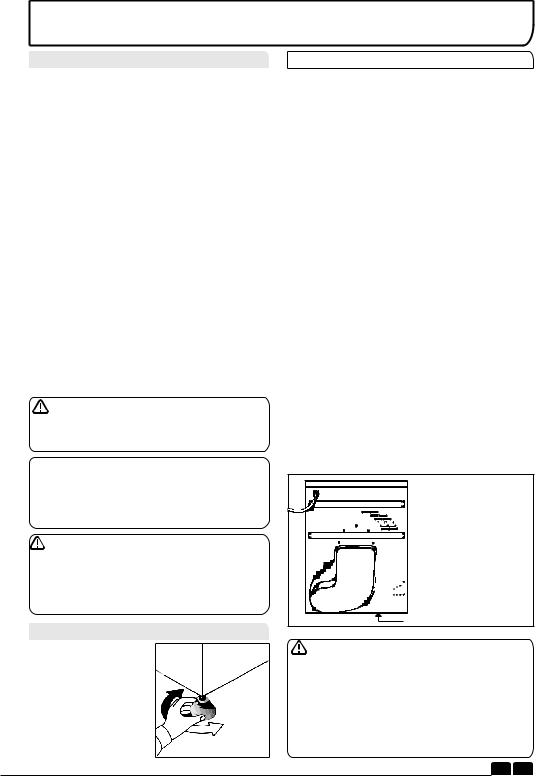
Elektro-Anschluss
Dieser Trockner ist für eine Netzspannung von 230 V und 50 Hz (Einphasenstrom) ausgelegt. Stellen Sie sicher, dass der Stromkreis eine Nennleistung von 10 A hat.
●Strom kann lebensgefährlich sein.
●Dieses Gerät muss an eine geerdete
Steckdose mit Schutzkontakt angeschlossen werden.
●Die Steckdose und der Stecker am Gerät müssen vom selben Typ sein.
●Verwenden Sie keine Mehrfachstecker und/oder Verlängerungskabel.
●Der Stecker sollte so angebracht werden, dass er nach der Installation des Geräts leicht aus der Steckdose zu ziehen ist.
Das Gerät stimmt mit den Bestimmungen der Europäischen Vorschrift 2004/108/EC, 2006/95/ EC sowie deren Nachfolgebes-timmungen überein.
Falls ein Problem mit Ihrer Maschine durch falsche Installation verursacht wird, müssen Sie Reparaturarbeiten möglicherweise selbst bezahlen.
 Sollte das Netzanschlusskab el an diesem Gerät beschädigt sein, muss es durch ein spezielles Kabel ersetzt werden, das NUR beim Ersatzteilservice erhältlich ist. Es muss von einer fachkundigen Person installiert werden.
Sollte das Netzanschlusskab el an diesem Gerät beschädigt sein, muss es durch ein spezielles Kabel ersetzt werden, das NUR beim Ersatzteilservice erhältlich ist. Es muss von einer fachkundigen Person installiert werden.
Schließen Sie die Maschine erst an und drücken Sie die Einschalttaste erst, wenn die Installation abgeschlossen ist. Zu Ihrer eigenen Sicherheit muss der Trockner richtig installiert werden. Sollten Sie bezüglich der Installation Fragen haben, wenden Sie sich an den GIAS Service.
Einstellen der Füße
S o b a l d s i c h d i e M a s c h i n e a m e n d g ü l t i g e n O r t befindet, sollten die
Füße so eingestellt w e r d e n , d a s s d i e Maschine eben steht.
INSTALLATION
ENTLÜFTUNG
In dem Raum, in dem sich der Trockner befindet, muss eine ausreichende Entlüftung vorhanden sein, um zu verhindern, dass Gase aus der Verbrennung anderer Brennstoffe, zum Beispiel offene Feuer, während desTroc-knerbetriebs in den Raum gesogen werden.
●Die Abluft darf nicht in einen Kaminschacht geleitet werden, der für das Ableiten von Rauch aus der Verbrennung von Gas oder anderen Brennstoffen verwendet wird.
●Prüfen Sie regelmäß ig die reibungslose Luftzirkulation im Trockner.
●Überprüfen Sie nach Gebrauch das Flusen-sieb und reinigen Sie es, wenn es erforderlich ist!
●Die Ansaugund Abluftanschlüsse dürfen nicht zugestellt werden. Um eine richtige Abluft zu gewährleisten, muss die Fläche zwischen dem Boden der Maschine und dem Fußboden frei bleiben. Zwischen der Masch-ine und anderen Gegenständen sollte ein Abstand von mindestens 12 mm eingehalten werden .
●Achten Sie darauf, dass keine Gegenstände zwischen beiden Seitenteilen und der Rück-seite des Trockners herunterfallen und sich dort ansammeln, da hierdurch die Ansaugund Abluftanschlüsse blockiert werden können.
●Der Trockner darf AUF KEINEN FALL in der unmittelbaren Nähe von Vorhängen aufgestellt werden.



 Luftansaugöffnung
Luftansaugöffnung




 Abluftanschlüsse
Abluftanschlüsse
Abluftanschlüsse Im Sockel
Bitte stellen Sie das Produkt nicht in Räumen auf, in denen Frostgefahr besteht. Bei Temperaturen um den Gefrierpunkt kann es sein, dass das Gerät nicht einwandfrei funktioniert: sich im Gerät befindliches Wasser könnte gefrieren und es dadurch beschädigen (Ventile, Schläuche,
Pumpen). Um einen einwandfreien Betrieb zu gewährleisten, sollte die Raumtemperatur zwischen +2°C and +35°C liegen.
DE 29
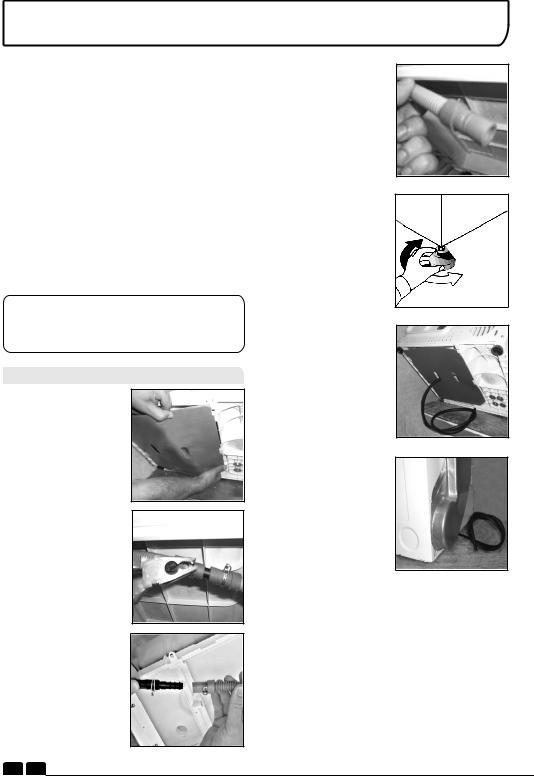
ABLAUFSET – MONTAGEANLEITUNG
Damit der Kondenswasserbehälter nicht nach jeder Nutzung des Gerätes geleert werden muß, kann das Wasser auch über ein Ablaufset ( o p t i o n a l e s Z u b e h ö r ) d i r e k t i n d e n H a u s a b w a s s e r a n s c h l u ß ( n o r m a l e r Hausabwasseranschluß, wie etwa der der Spüle) abgeleitet werden. Eine Ableitung des Wassers ohne festen Anschluß (etwa in eine Sickergruße) ist nicht möglich.
Der Abwasseranschluß sollte sich in der Nähe des Wäschetrockners befinden (max. Entfernung=Länge des im Set gelieferten Standardschlauchs, eine Verlängerung ist nicht möglich)
Das Ablaufset besteht aus folgenden Komponenten: 1 Schlauch sowie 1 Zubehörteil zum Schließen eines verbleibenden Schlauchs.
 ACHTUNG! Bitte unbedingt das Gerät abschalten und den Stecker vom Stromnetz trennen, bevor Sie mit den nachfolgend beschriebenen Montageschritten beginnen.
ACHTUNG! Bitte unbedingt das Gerät abschalten und den Stecker vom Stromnetz trennen, bevor Sie mit den nachfolgend beschriebenen Montageschritten beginnen.
Bitte das Kondenswasserablaufset wie Folgt Montieren:
1.D e n T r o c k n e r vorsichtig nach hinten neigen.
2.D i e S c h u t z a b - deckung vorsichtig d u r c h Z i e h e n entfernen. Sie wird nach Abschluß der M o n t a g e a r b e i t e n wieder benötigt; bitte aufbwahren.
3.Der Anschluß für das Ablaufset befindet sich auf der rechten Seite d e s G e r ä t e s ( s . Abbildung). Ein grauer Schlauch führt dort zu einem Verbindungsstück. Mit Hilfe einer Zange die Fixierungsklemme lösen.
4.Den Schlauch vom Ve r b i n d u n g s s t ü c k abziehen.
5. Nun den schwarzen S c h l a u c h d e s Ablaufsets mit dem g r a u e n S c h l a u c h verbinden und gut mit der Klemme fixieren, so dass dieser nicht v e r s e h e n t l i c h abrutschen kann.
6.D a s a n d e r e ,
ve r b l e i b e n d e Schlauchende mit dem mitgelieferten Zubehör schließen.
7.Den schwarzen Ablaufschlauch nun durch die Öffnungen der Schutzabdeckung führen.
8.D i e S c h u t z a b - deckung vorsichtig
wi e d e r a m G e r ä t anbringen und dabei
u n b e d i n g t s i c h e r - stellen, dass der im Gerät verbleibende Teil des Schlauchs nicht geknickt wird.
9. Nachdem das Gerät wieder betriebsbereit am Aufstellort platziert wurde, bitte das Gerät m i t H i l f e d e r verstellbaren Füße ausnivellieren und u n b e d i n g t s i c h e r - s t e l l e n , d a s s d e r Ablaufschlauch nicht abgeknickt wurde.
10.Den schwarzen Ablaufschlauch an das Abwasserrohr/-system anschließen.
11.Das Gerät wieder an das Stromnetz anschließen.
DE 30
